ecosystem-guides.com
....exploring the planet's ecosystems
INDO-PACIFIC
Coral Reef
The tropical coral reefs are the most beautiful ecosystem in the world - there, I said it!
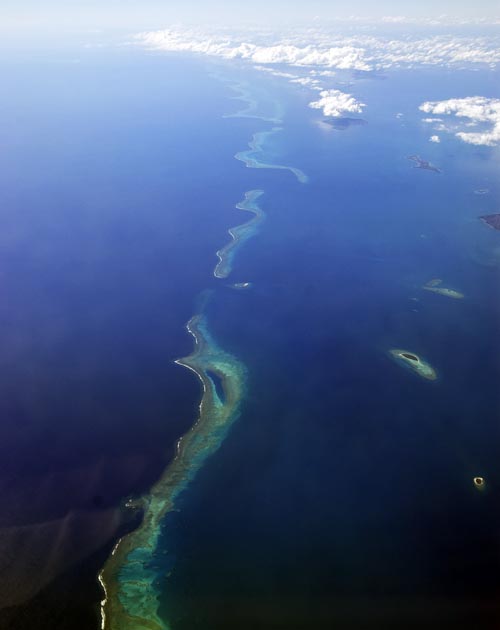
Because they are not as colourful as the glamorous sponges and corals, algae often gets ignored on the coral reefs; however, 'seaweeds' can be very common, especially in disturbed, murkier or more nutrient-rich areas.
Of the brown algae, Padina ‘Funnel weed’ are a very distinctive group. They are light brown, fan shaped, with distinctive concentric circles, giving them the appearance of shelf or bracket fungi. They differ from the other round brown seaweeds by the outer rim, which is thickened and curled in, and the regular ear-like folds. The fine lines are made up of rows of microscopic hairs, while the thicker darker bands are made up of reproductive spore structures. The pattern of these lines help in distinguishing different species of Padina. Some specimens may develop a slight chalky thickening on the surface, due to calcification; they are the only group of brown seaweeds that do this. Funnel weed can be common in coral and rubble shallows, and they appear to be more common where it is a little murkier.
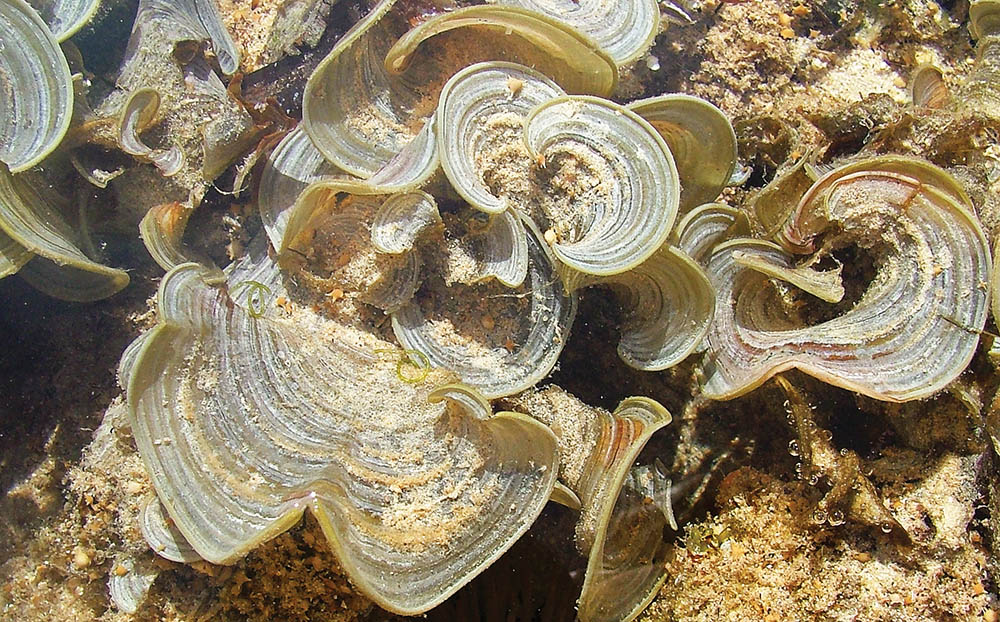
In the green algae, the very large genus Caulerpa of ‘Sea Grapes’ contains a variety of quite different looking green seaweeds. From a creeping stolon grow several upright bunches, with (depending on the species) bubble or leaf-like vesicles. Some are very common, such as Caulerpa racemosa, which is found throughout shallow tropical seas of the world
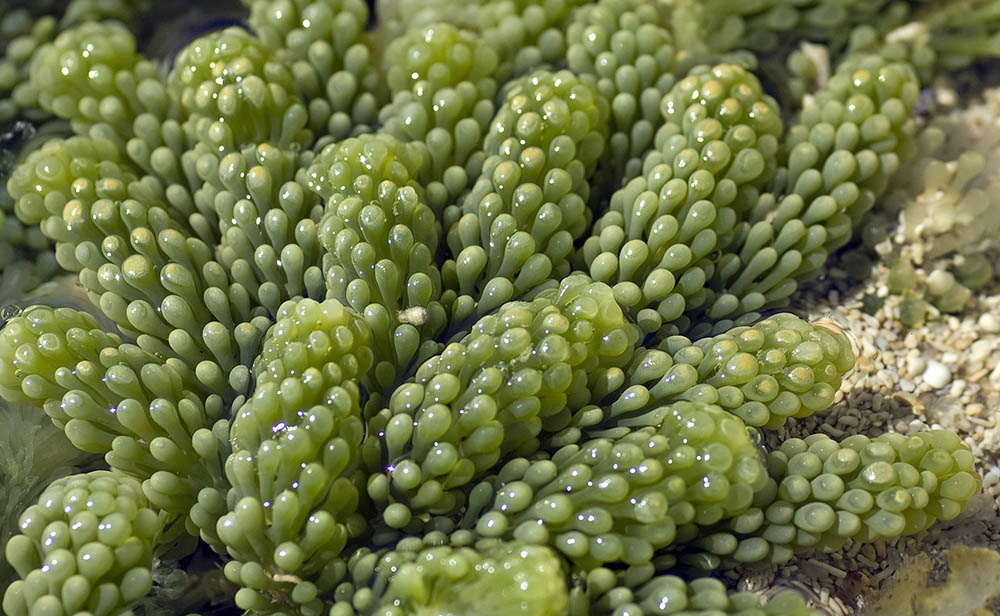
Because of the generally clearer and nutrient poor waters of the tropical seas, sponges are not always as noticeable in the warmer waters as they are along the cooler coastlines. However, smaller and very attractively coloured species are present around coral reefs. Sponges have what is often considered the most basic body plan of all the multi-cellular animals. They are sedentary as adults, and resemble plants in their simplicity and adherence to the substrate. Because of their simplicity and stillness, they were originally classified as a plant, and were only recognized as an animal in 1765 when their internal water currents were noticed. They vary in form, with some species growing distinctly shaped structures that look like balls, large cups or funnels, or they may simply grow as encrusting layers. The largest are the 'Barrel Sponges'. Many of the tropical sponges, especially on coral reefs, can be quite colourful.
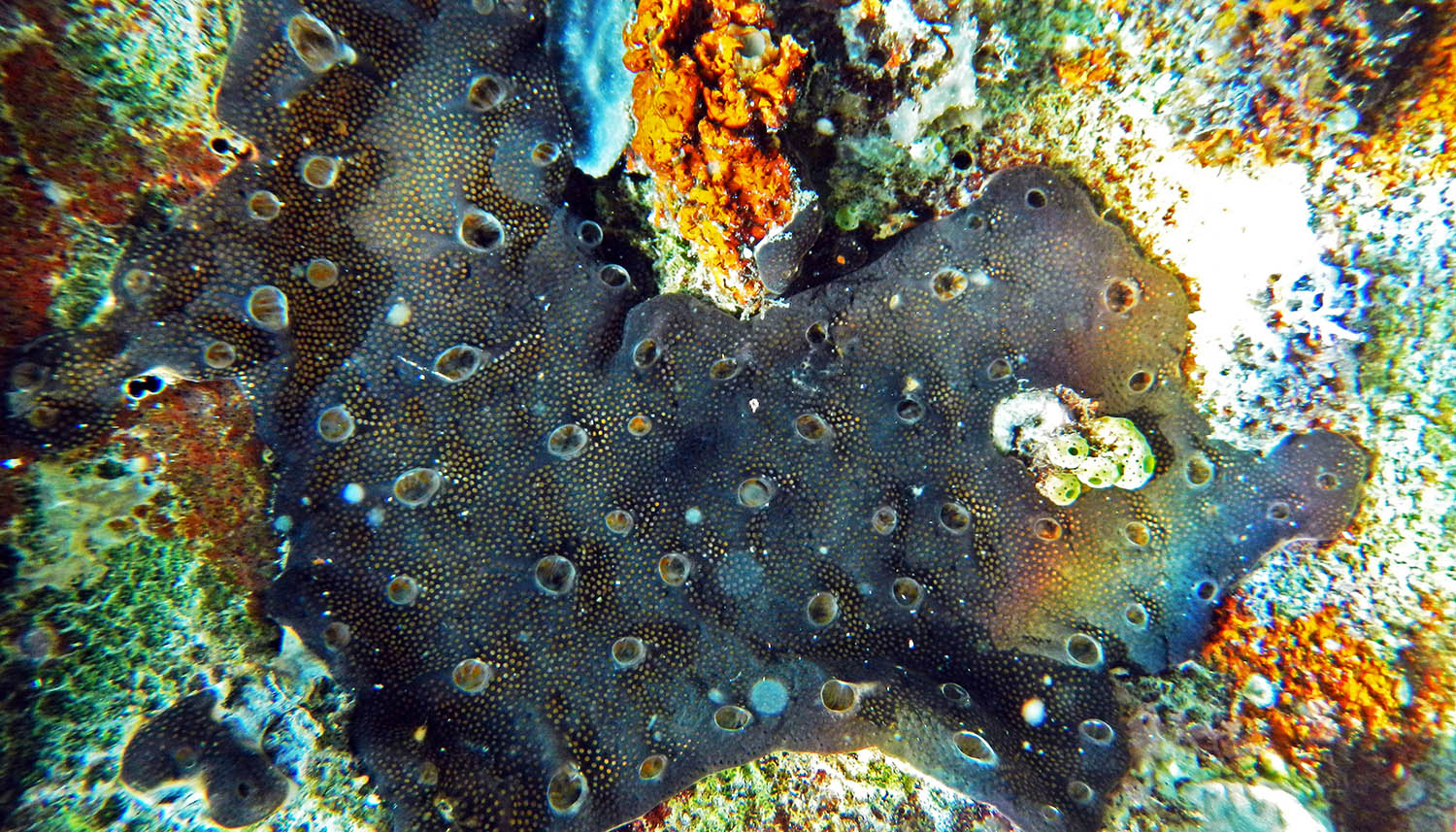
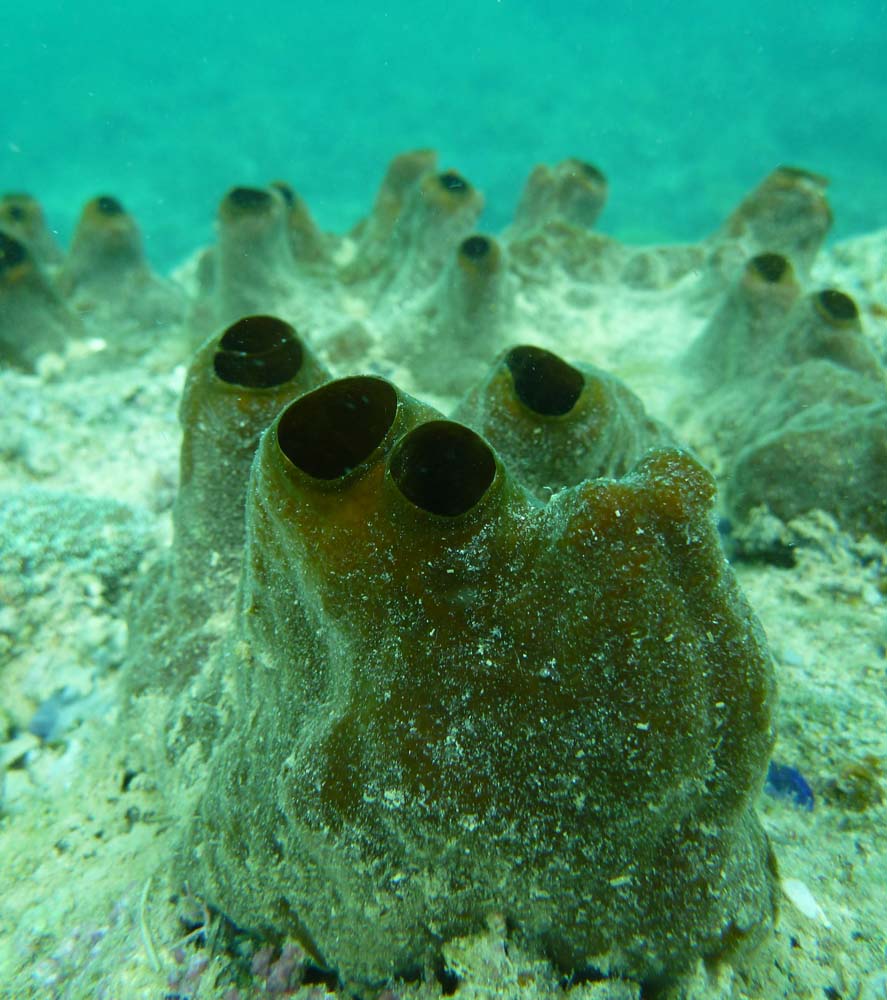
Of course the most obvious and important animal on coral reefs are the corals themselves. There are various groups referred to as 'corals', and not all are closely related, but the group we usually think of when we imagine corals are the 'Hard Corals' of the order Scleractinia.
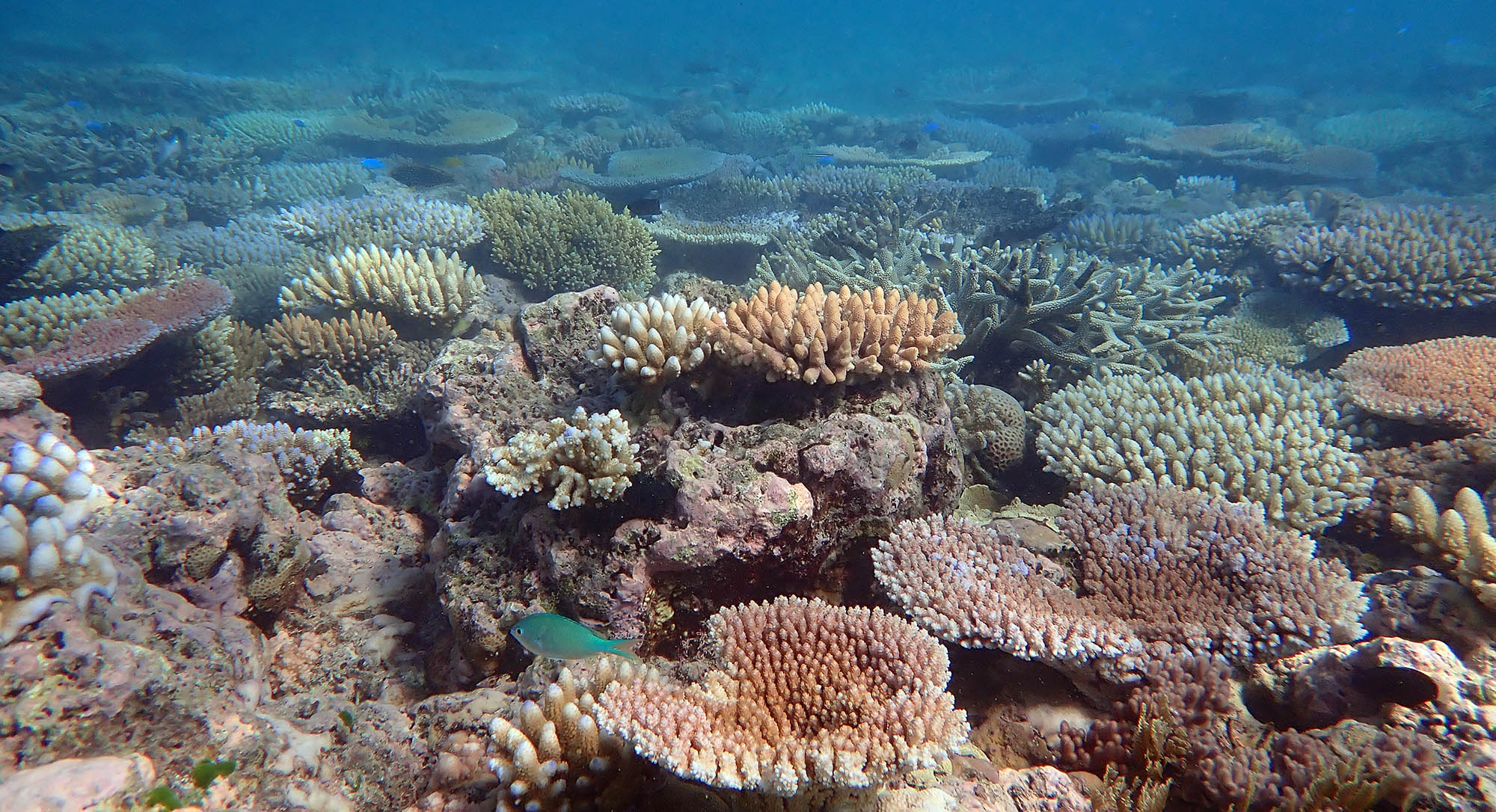
The largest and usually most obvious species belong to the genus of coral Acropora. Even the same species can grow in many forms, thus they have many common names such as 'Staghorn', 'Table' and 'Plate' Coral.
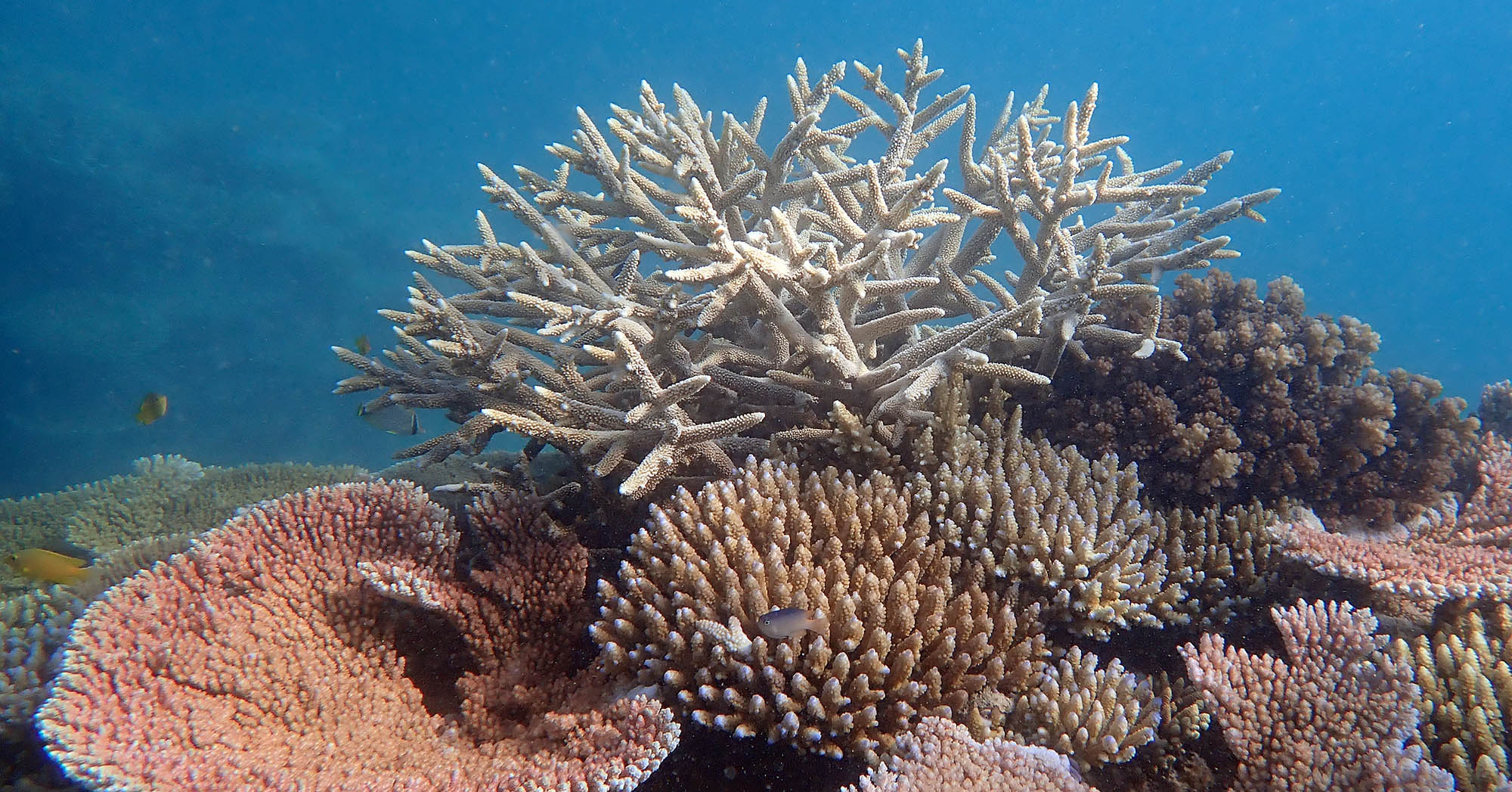
The second largest genus, but much less recognized, is Montipora. Like Acropora, they can grow in many forms, from staghorn to flat plates, sometimes even in the same colony. The colours vary. One of their distinguishing features is the small size of the corallites (the small holes the polyps live in); they are the smallest of any coral group.
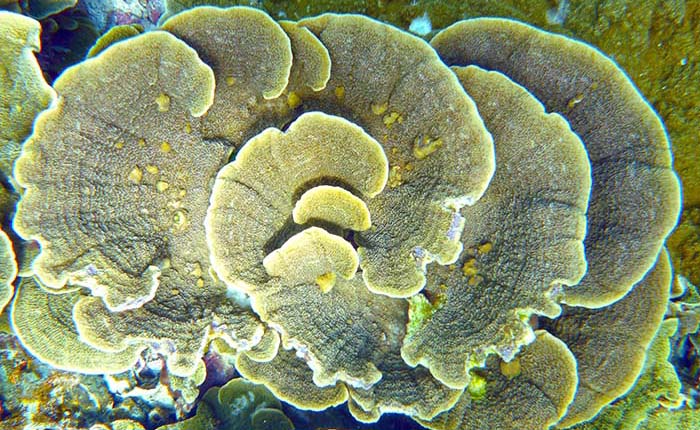
The class Polychaeta includes a great range of 'worms' on and through the coral reefs, many of which are not related to each other. While most species are not seen, some, like the 'Feather Duster Worms' and 'Christmas Tree Worms', have colourful and noticeable fluffy feeding apparatus.
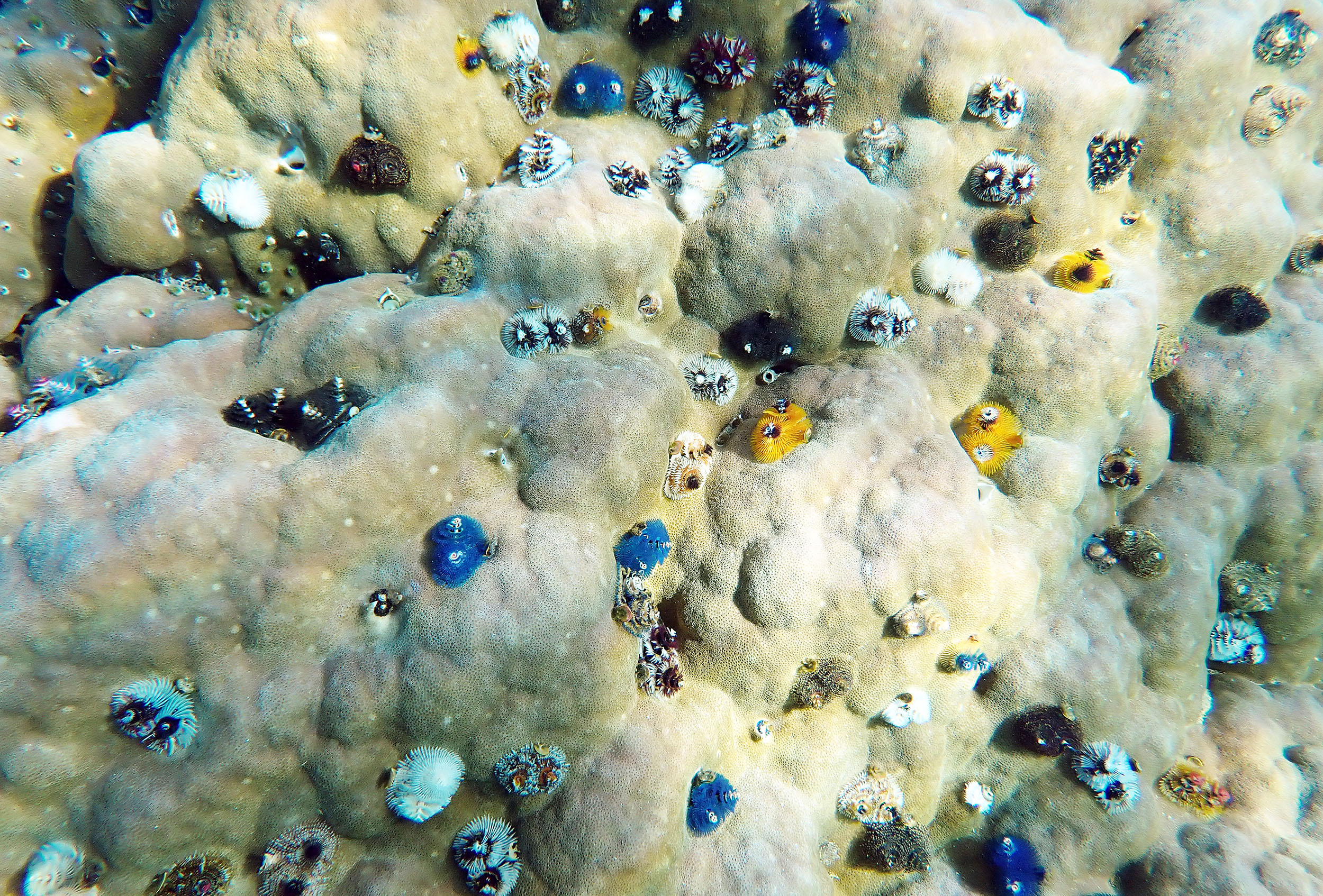
One of the prettiest and most photogenic groups of animals on the reefs are the 'Feather Stars' of the class Crinoidea. For most of their life, they stand on reefs and catch food as it passes by through the water. Featherstars usually attach to coral on the edge of drop-offs and/or near areas with some flow of water. They are capable of 'swimming' freely. There is a huge range of colours and combinations of colours.
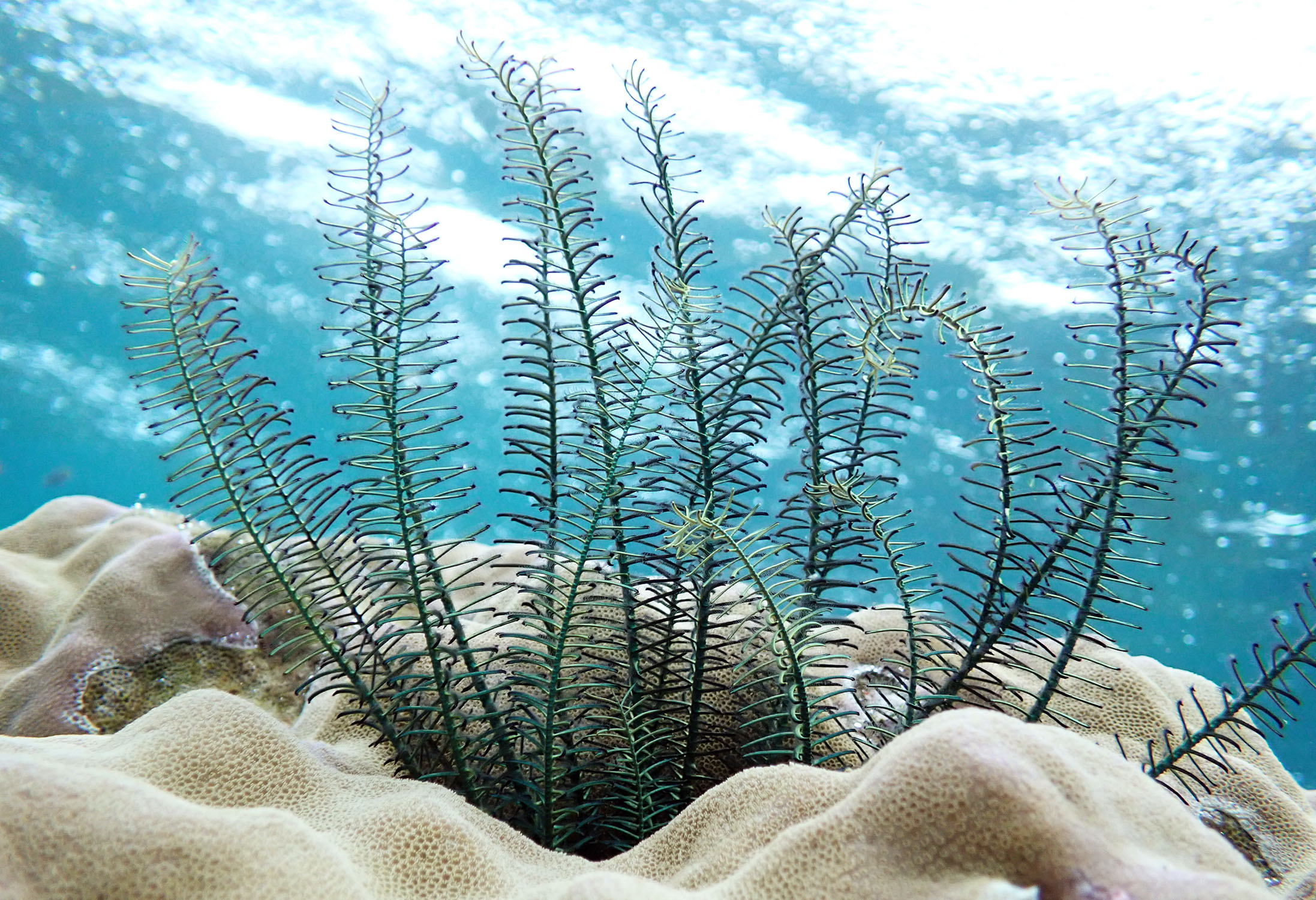 (Wagifa, PNG)
(Wagifa, PNG)The class Holothuroidea includes the 'Sea Cucumbers'. As slow moving and large animals, they are commonly seen around coral reefs. Most species sift through the sand looking for food.
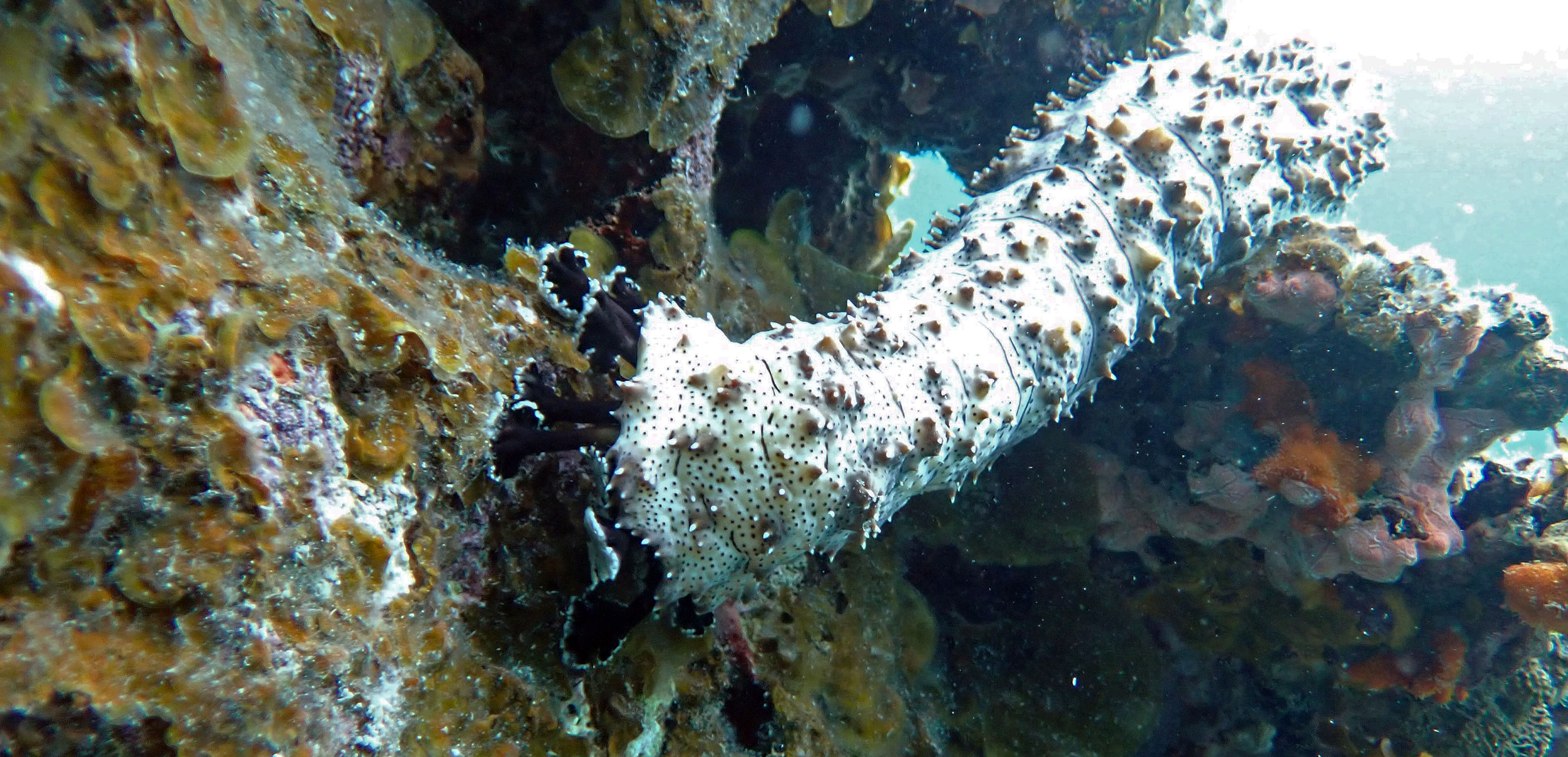
Sea Squirts of the class Ascidiacea look superficially similar to Sponges, however, they are about as unrelated as an 'invertebrate' can be.
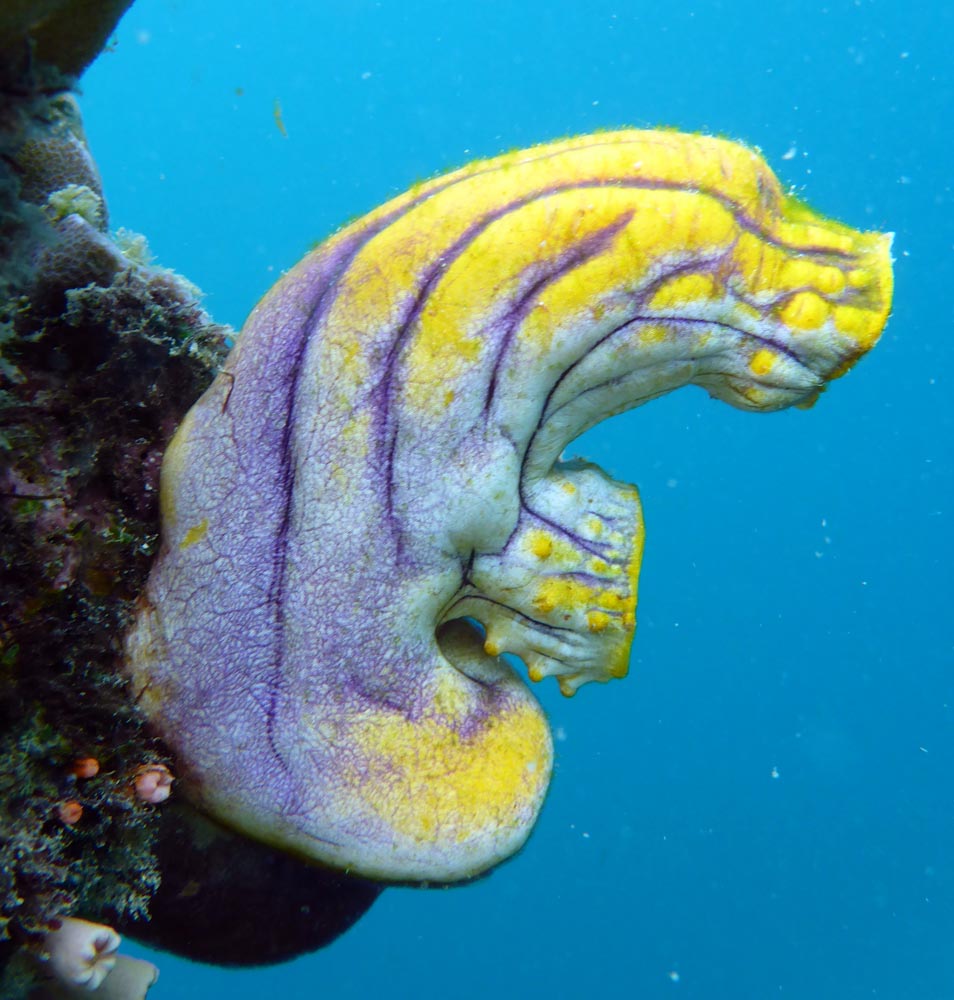 Polycarpa aurata, (Rajah Ampat, Indonesia)
Polycarpa aurata, (Rajah Ampat, Indonesia)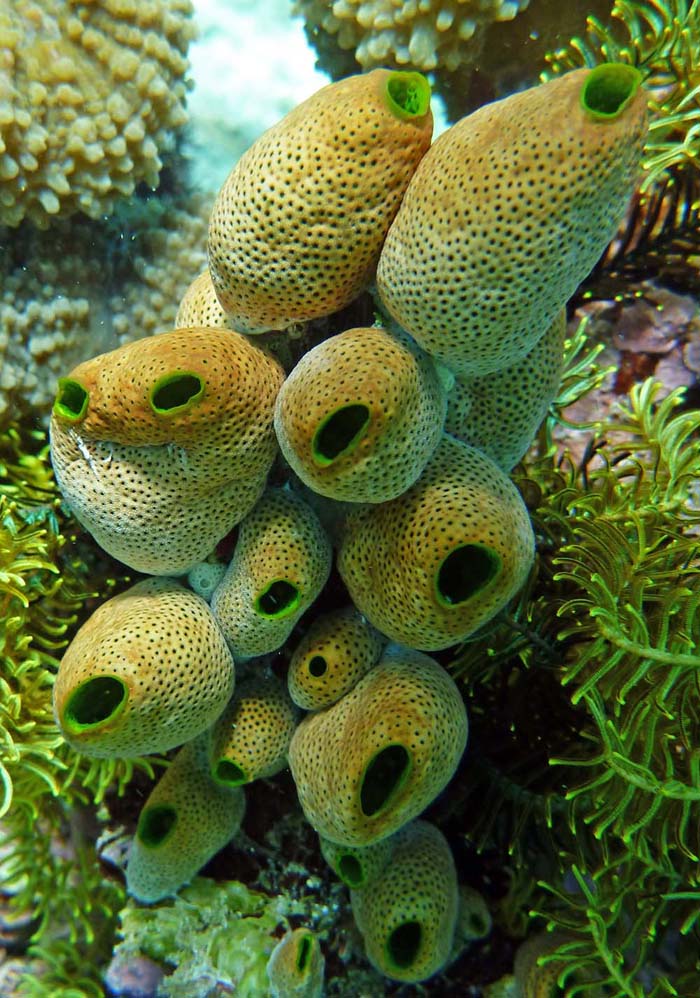 (Pink Beach, Indonesia)
(Pink Beach, Indonesia)The class Chrondrichthyes includes the sharks and the rays. The rays include species that are mostly found sliding along the sea floor (below left), as well more open water species found higher in the water column (below right).
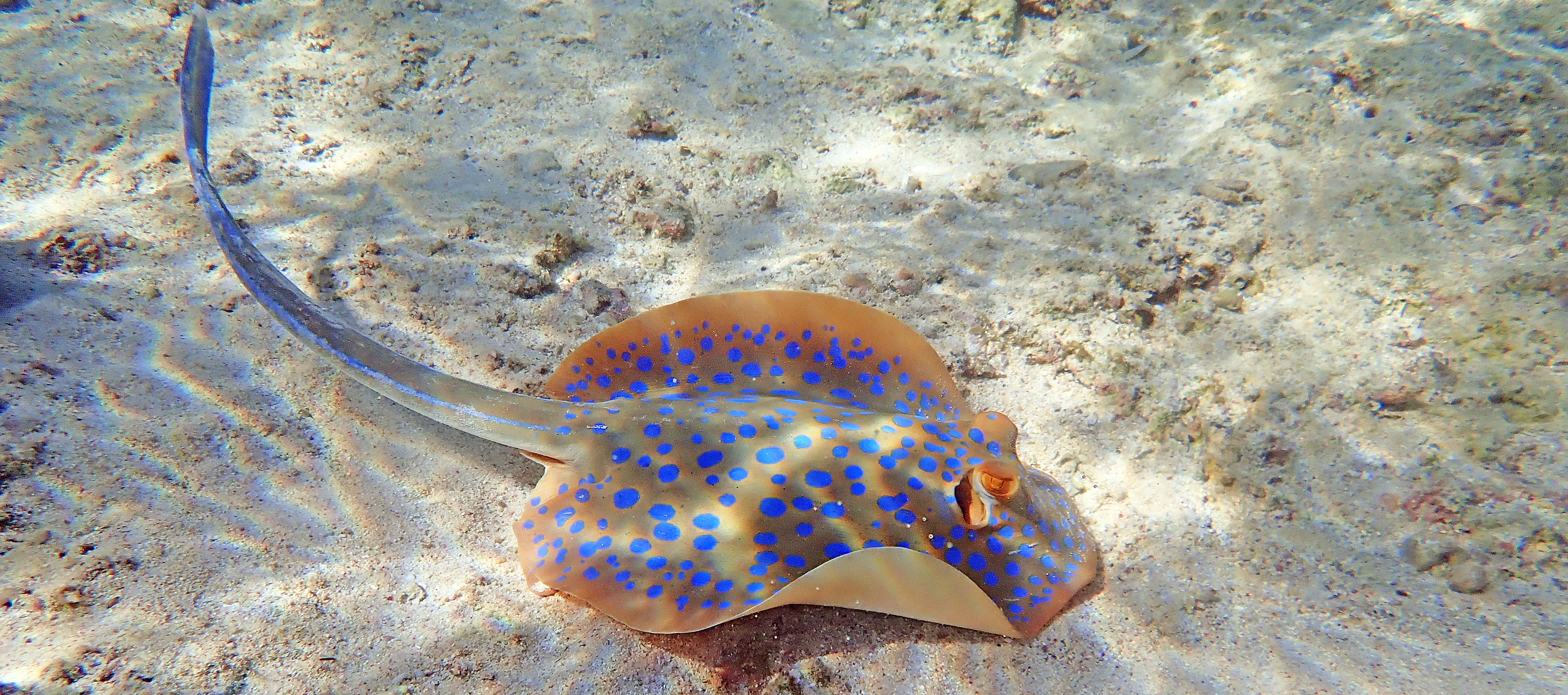 'Blue-spotted Fantail Ray' (The Stacks, Ningaloo, Western Australia).
'Blue-spotted Fantail Ray' (The Stacks, Ningaloo, Western Australia).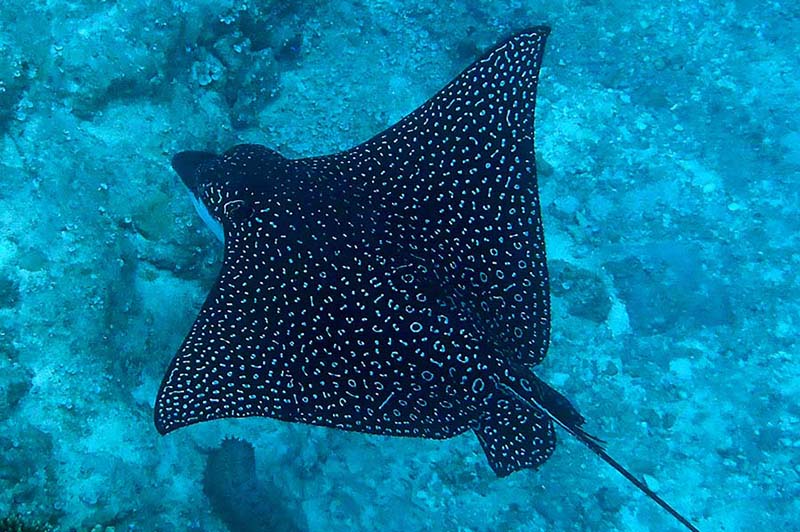 'Spotted Eagle Ray' (Nuie).
'Spotted Eagle Ray' (Nuie).The family Muraenidae include the Moray Eels, fish that are often seen sliding in and out of cracks and holes in the coral reefs.
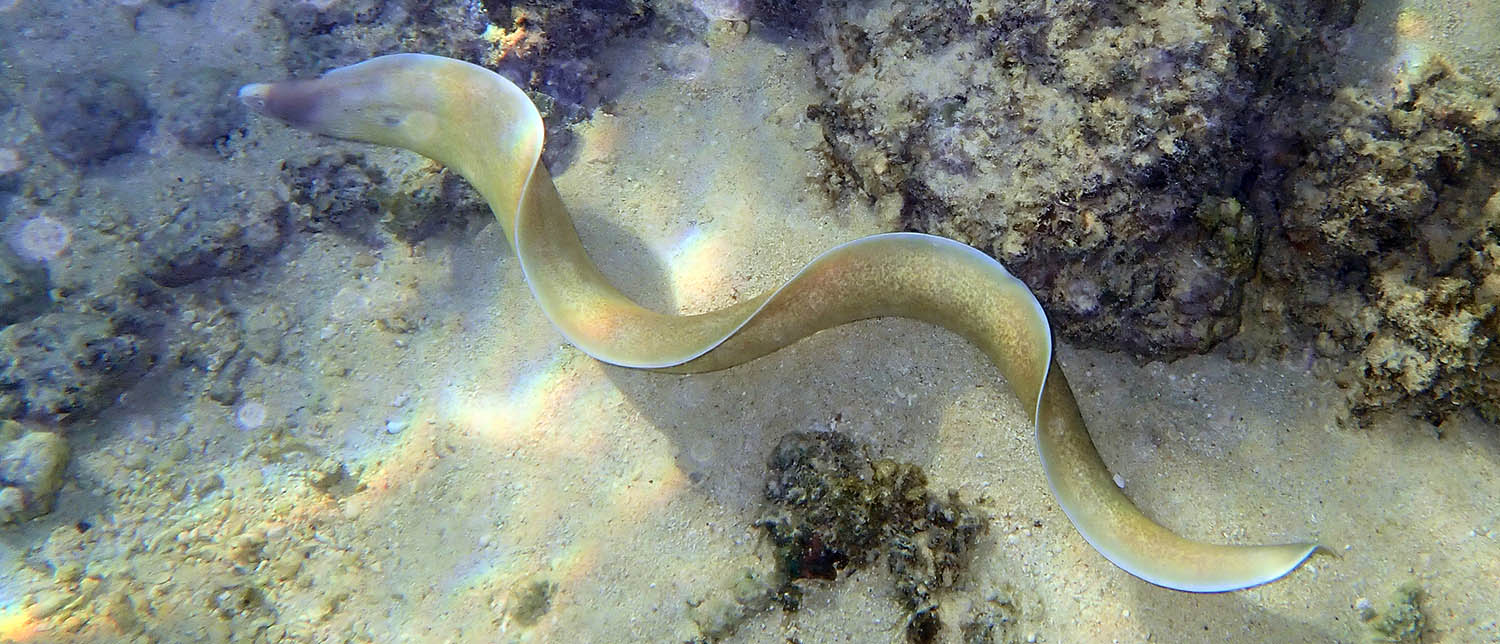 'Black-faced Moray Eel' (Turquoise Bay, Ningaloo Reef).
.
'Black-faced Moray Eel' (Turquoise Bay, Ningaloo Reef).
.The family Clupeidae include many of the smaller fish that usually school together in large groups, such as herrings and sardines.
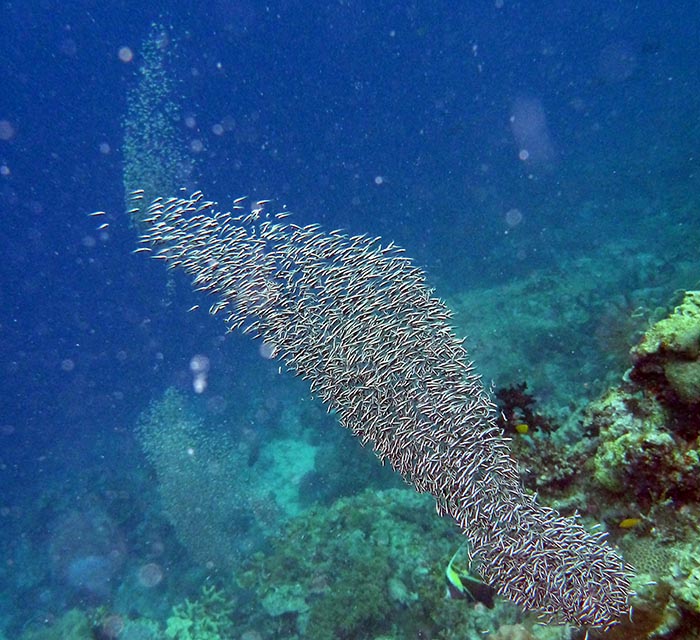
The family Family Scorpaenidae includes several dangerous species, including the "handsome...but deadly" lionfish and the ugly, but still dangerous, stonefish
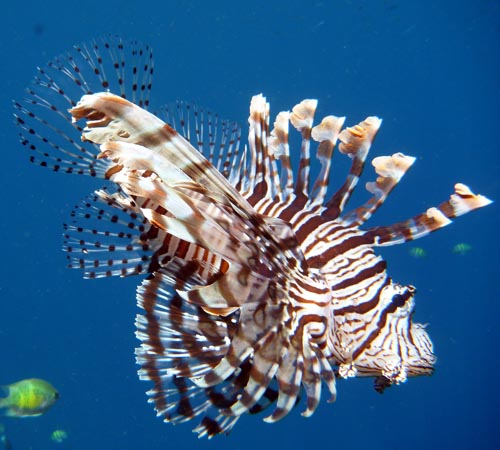 (Marovo Lagoon, Solomon Islands)
(Marovo Lagoon, Solomon Islands)The family Serranidae include the Groupers and Rock-cods, which includes some of the biggest bony fish found around coral reefs and some of the biggest predators.
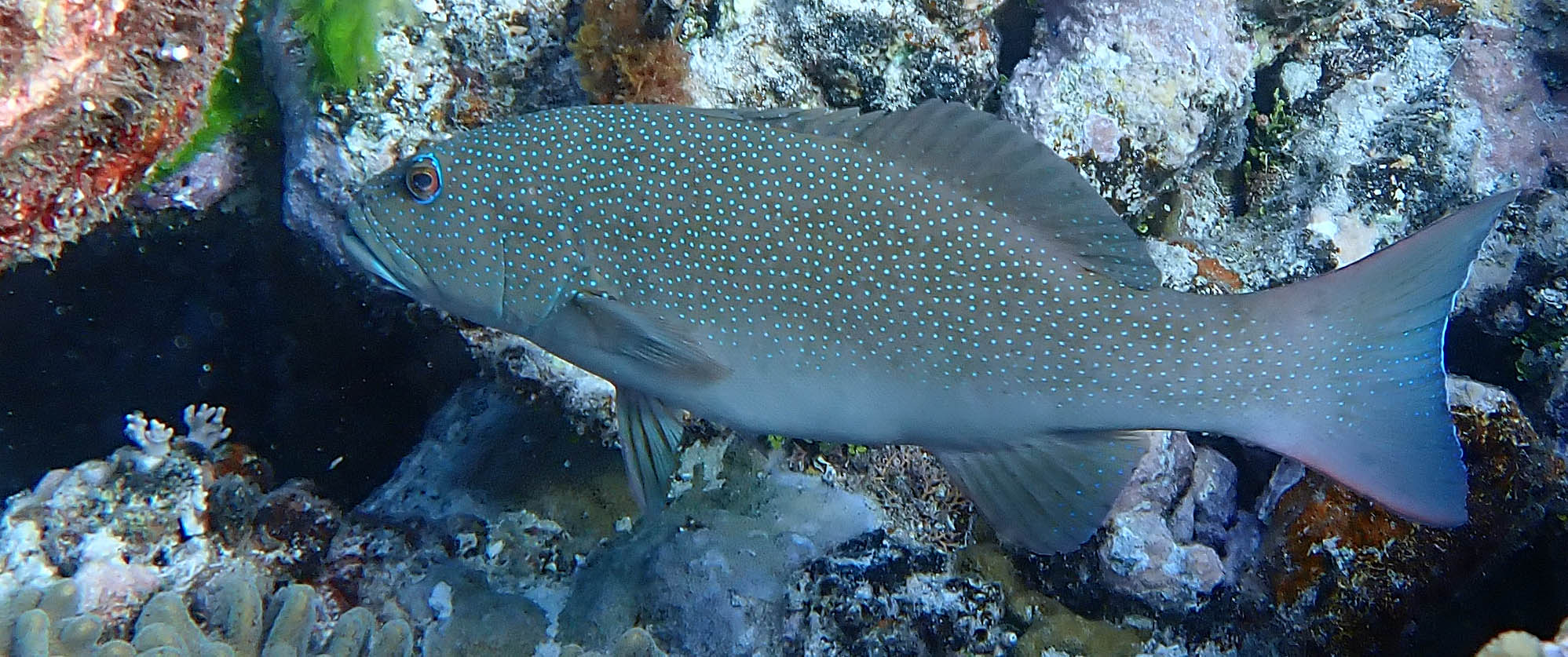 'Coral Trout', (Ribbon Reef Number 2, Great Barrier Reef, Australia)
'Coral Trout', (Ribbon Reef Number 2, Great Barrier Reef, Australia)The family Carangidae Includes the fast and predatory 'Trevally', known as 'Jacks' in the Americas.
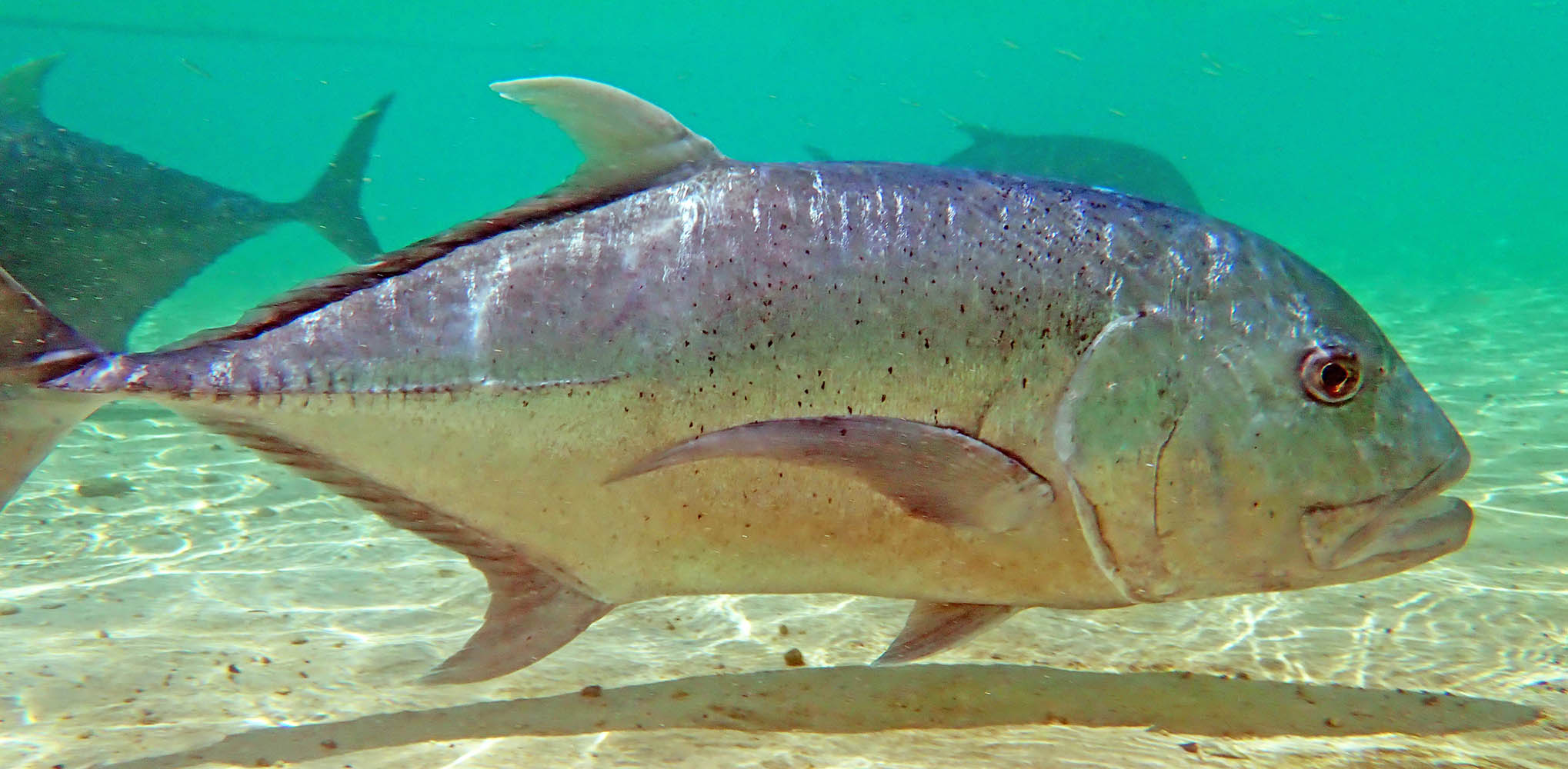 (Farquhar Atoll, Seychelles)
(Farquhar Atoll, Seychelles)The 'tropical snappers' of the family Lutjanidae are medium sized fish that often school in large numbers among the coral.
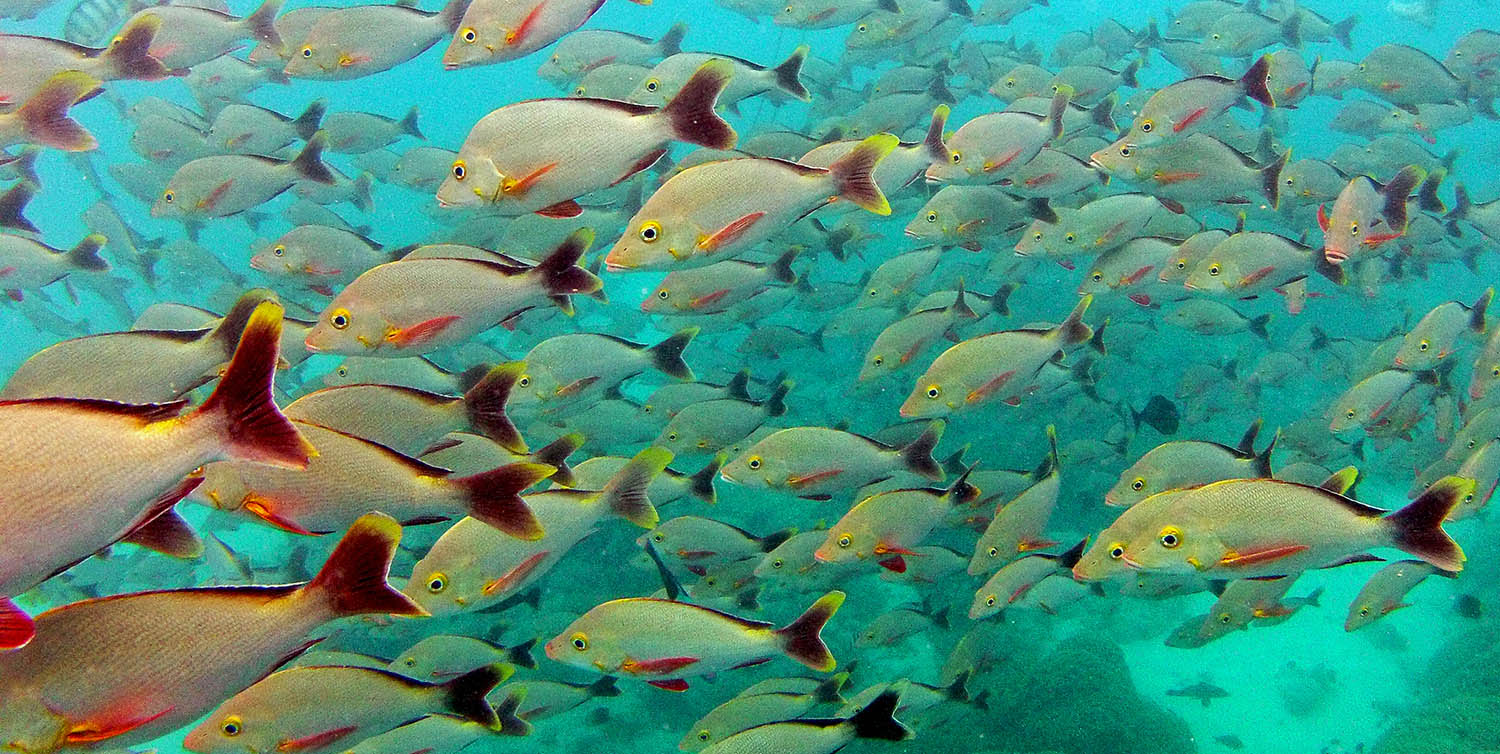 ‘Paddletail Snapper’.
‘Paddletail Snapper’.The Wrasse of the family Labridae include a large variety of medium to large colourful fish.
 'Black-barred/Jansen's Wrasse', (Tangalooma Wrecks, Moreton Island, Queensland).
'Black-barred/Jansen's Wrasse', (Tangalooma Wrecks, Moreton Island, Queensland).The 'cleaner wrasse' are a small group includes four species of cigar shaped and sized fish that specialise in feeding on the ectoparasites of other fish.
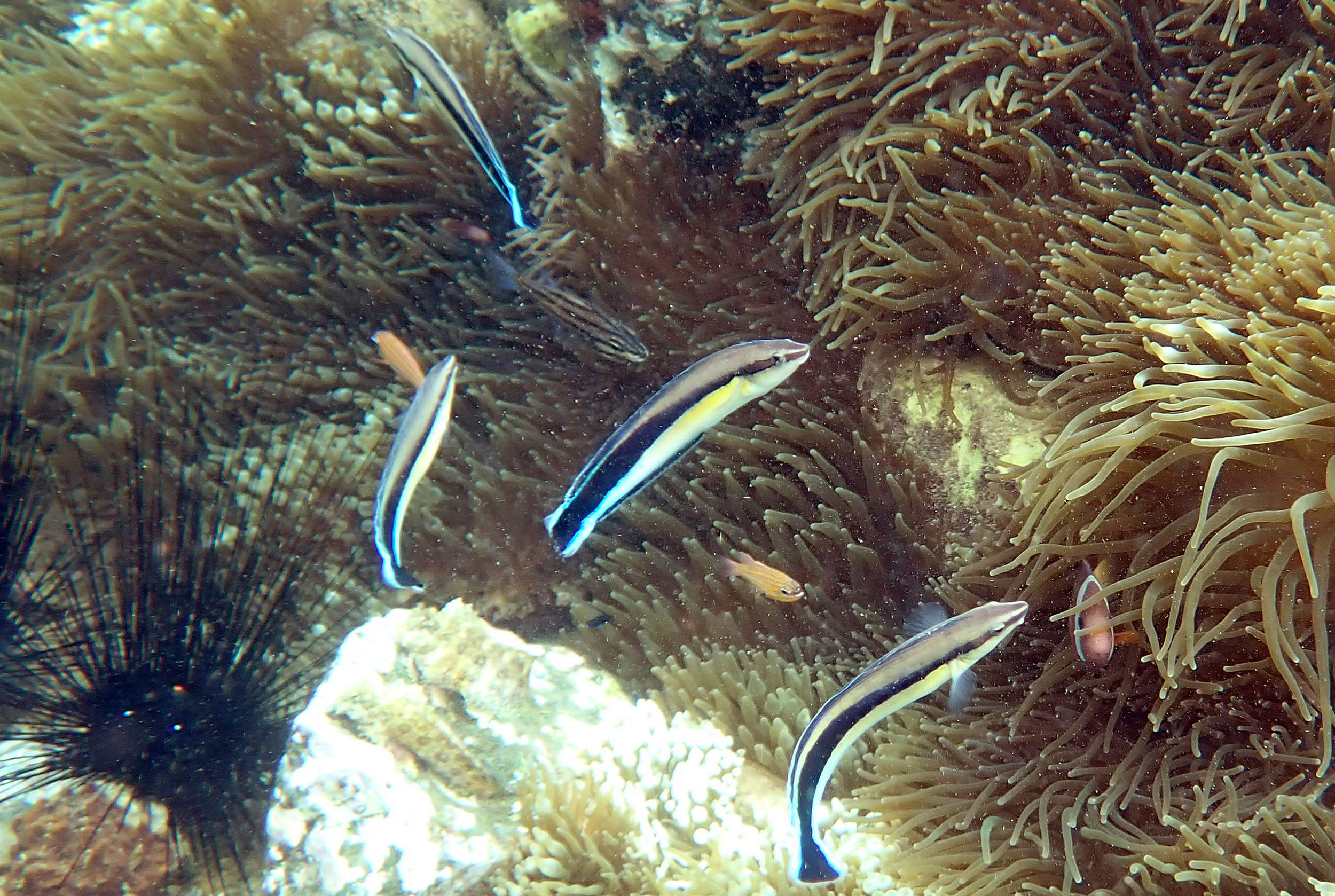 (Samarai, Papua New Guinea)
(Samarai, Papua New Guinea)The Parrotfish are a distinct group of Wrasse that have teeth fused into a large beak for scraping algae off coral.
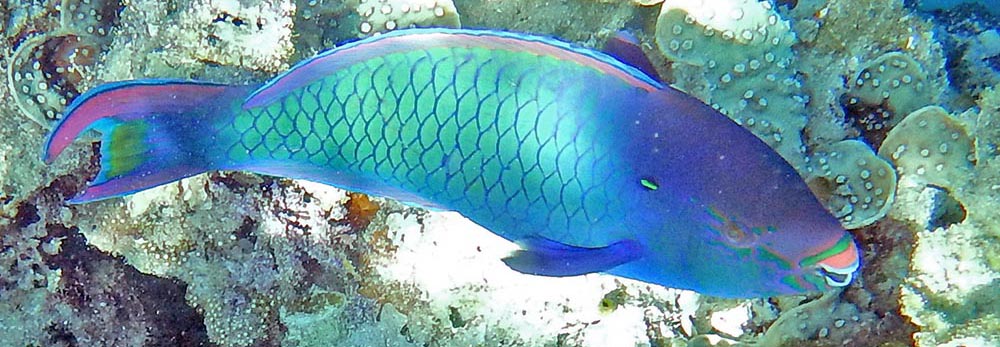 'Dusky-capped Parrotfish', (Bali Barat, Indonesia)
'Dusky-capped Parrotfish', (Bali Barat, Indonesia)The family Pomacentridae includes all the 'damselfish'. These are probably the most common and numerous group of fishes a casual snorkeller is likely to see. Most are small fish that most of their lives in a small territory.
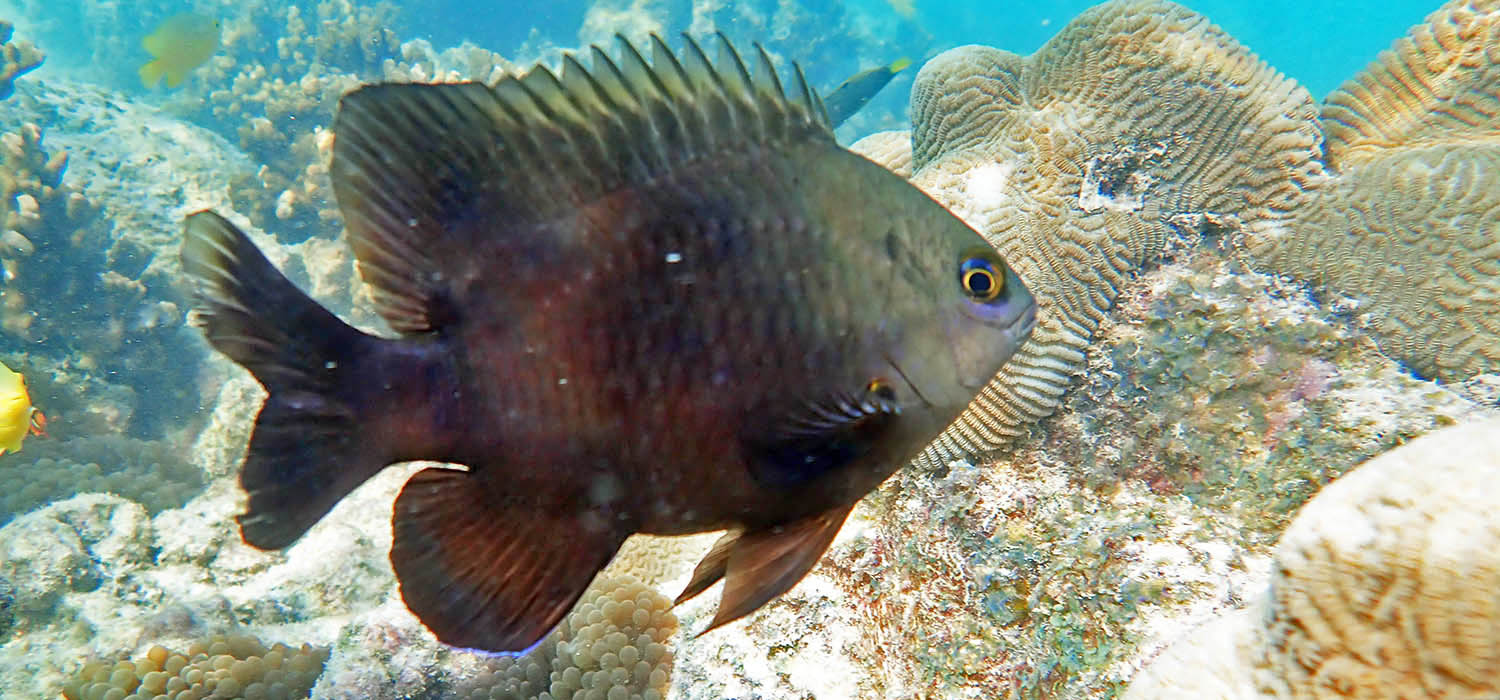 'Dusky Gregory', (Turquoise Bay, Ningaloo, Australia).
'Dusky Gregory', (Turquoise Bay, Ningaloo, Australia).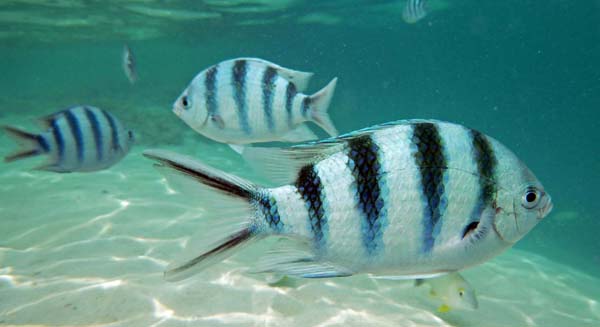 'Scisor-tail Sergeant', (Aitutaki, Fiji)
'Scisor-tail Sergeant', (Aitutaki, Fiji)One of the most best known subgroups of this family are the Amphiprion; the 'Anemonefish' or 'Nemos'. These colourful fish live their whole lives in a symbiotic relationship, wriggling in amongst the stinging tentacles of specific anemone hosts.
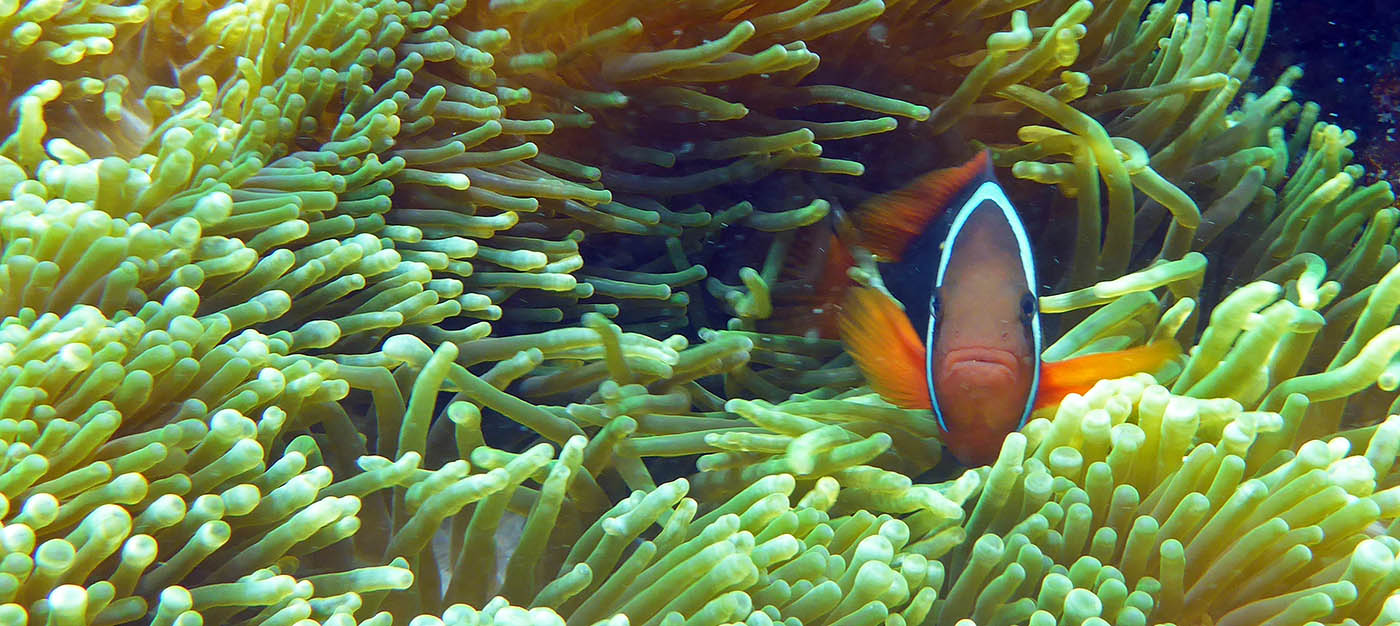 (Miyako, Japan)
(Miyako, Japan)The Butterflyfish of the family Chaetodontidae are medium sized fish that are extremely laterally compressed; that is, they have the shape of plate.
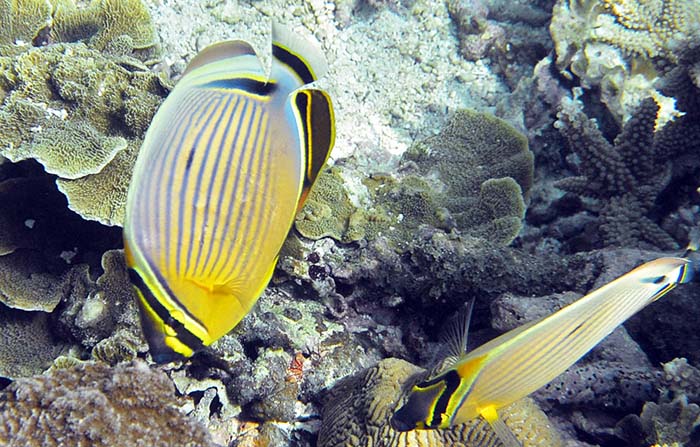 'Oval/Pacific Redfin Butterflyfish', (Miyako Island, Japan).
'Oval/Pacific Redfin Butterflyfish', (Miyako Island, Japan).They are usually dominated by black and yellow colours, but there are many variations.
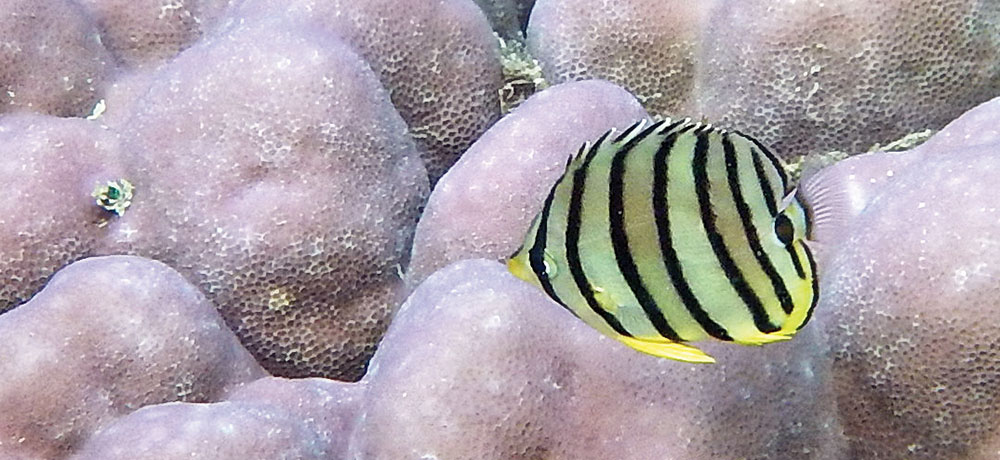 (Eight-banded Butterflyfish, Indonesia)
(Eight-banded Butterflyfish, Indonesia)Their elongated snouts of many species have evolved to predate on coral polyps.
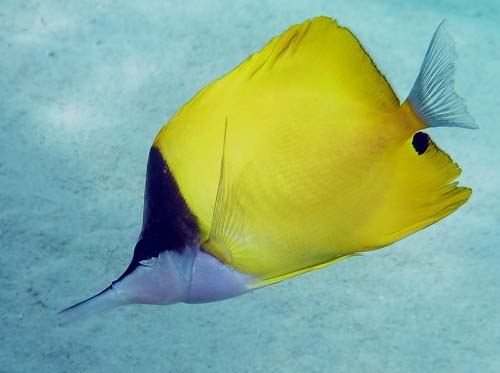 'Long-nosed Butterflyfish', (Aitutaki, Fiji)
'Long-nosed Butterflyfish', (Aitutaki, Fiji)Butterflyfish are usually found in pairs.This is my favourite group of fish! There are many species to identify, but all are distinct and relatively easy to identify...
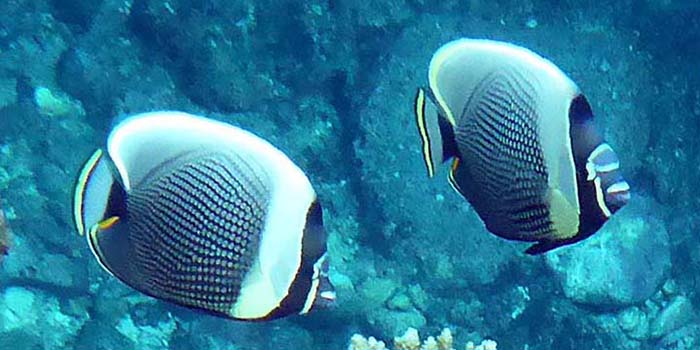 'Reticulated Butterflyfish', (Niue).
'Reticulated Butterflyfish', (Niue).The biggest genus Chaetodon, has been divided into various groups...
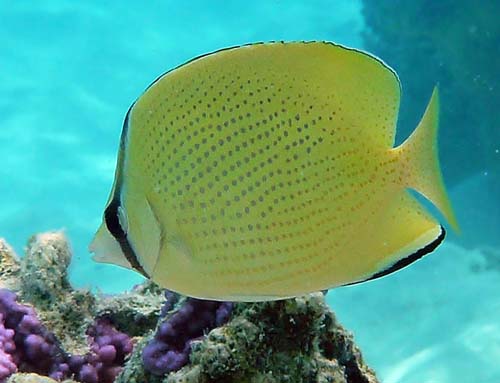 'Speckled Butterflyfish', (Aitutaki, Fiji).
'Speckled Butterflyfish', (Aitutaki, Fiji).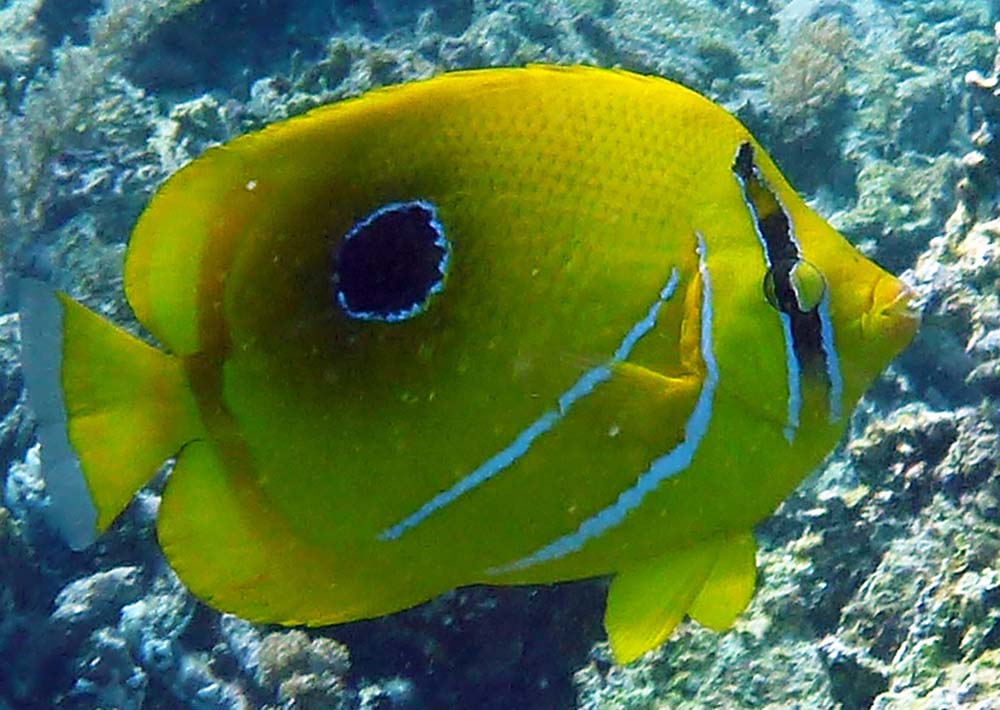 'Eclipse/Blue-lashed Butterflyfish', (Pink Beach, Komodo, Indonesia)
'Eclipse/Blue-lashed Butterflyfish', (Pink Beach, Komodo, Indonesia)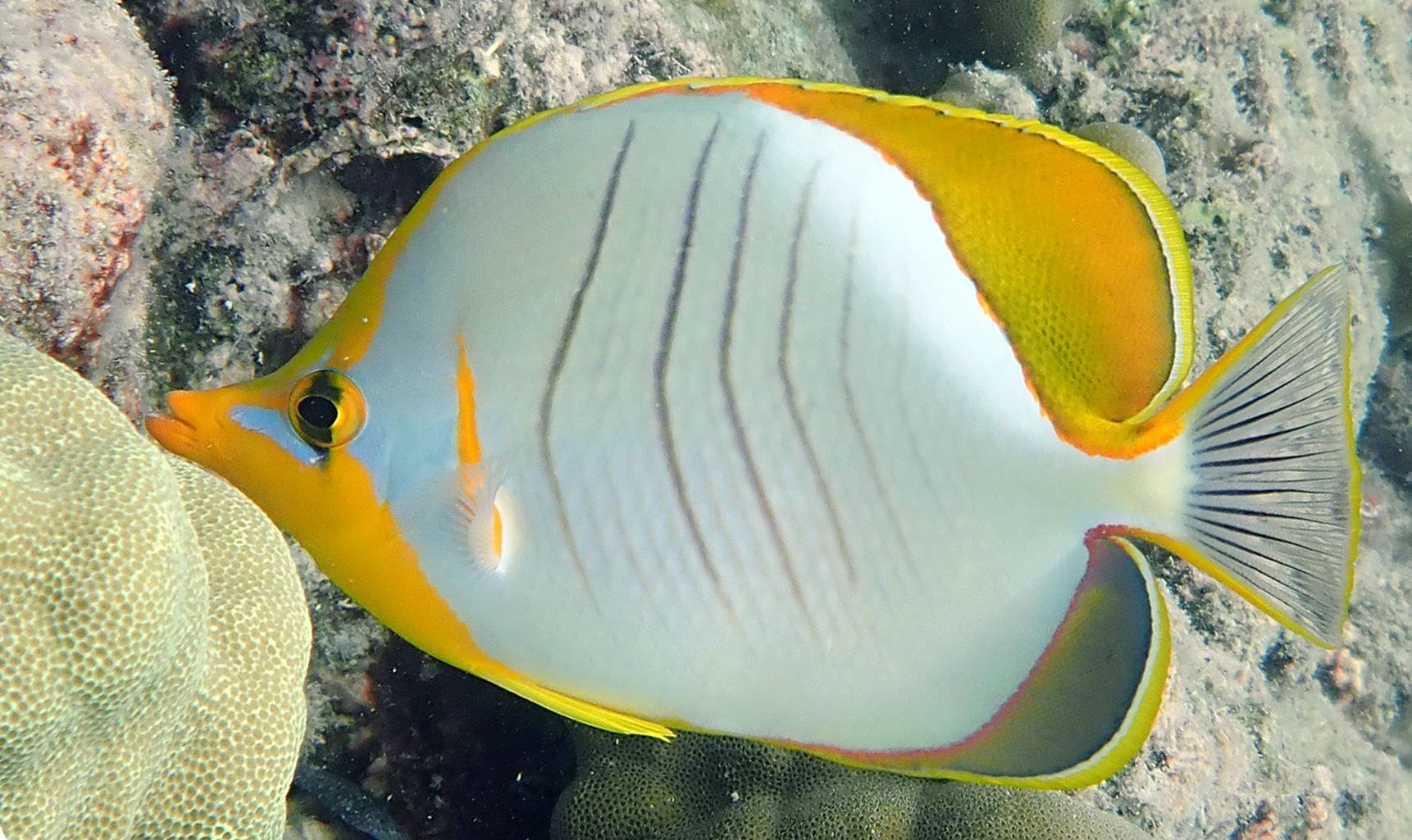 'Yellow-headed Butterflyfish', (Alphonsa, Seychelles).
'Yellow-headed Butterflyfish', (Alphonsa, Seychelles).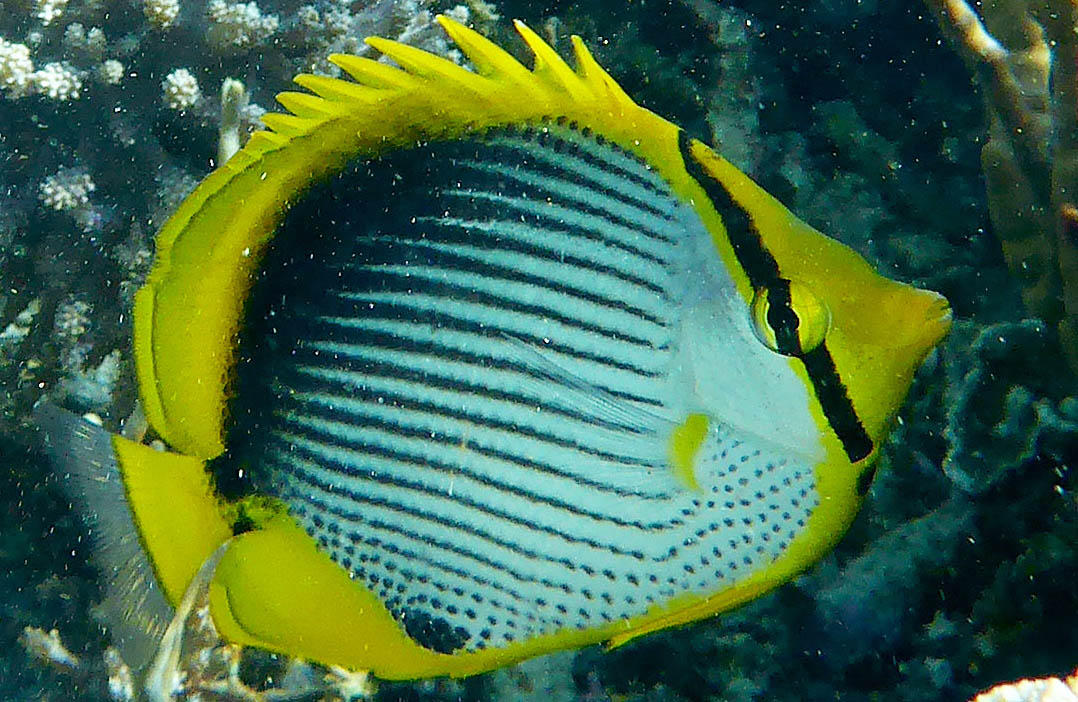 ‘Blackback Butterflyfish’, (Pink Beach, Indonesia).
‘Blackback Butterflyfish’, (Pink Beach, Indonesia).Like Butterflyfish, Angelfish are also rather plate-shaped. However, they are more squarish in profile.
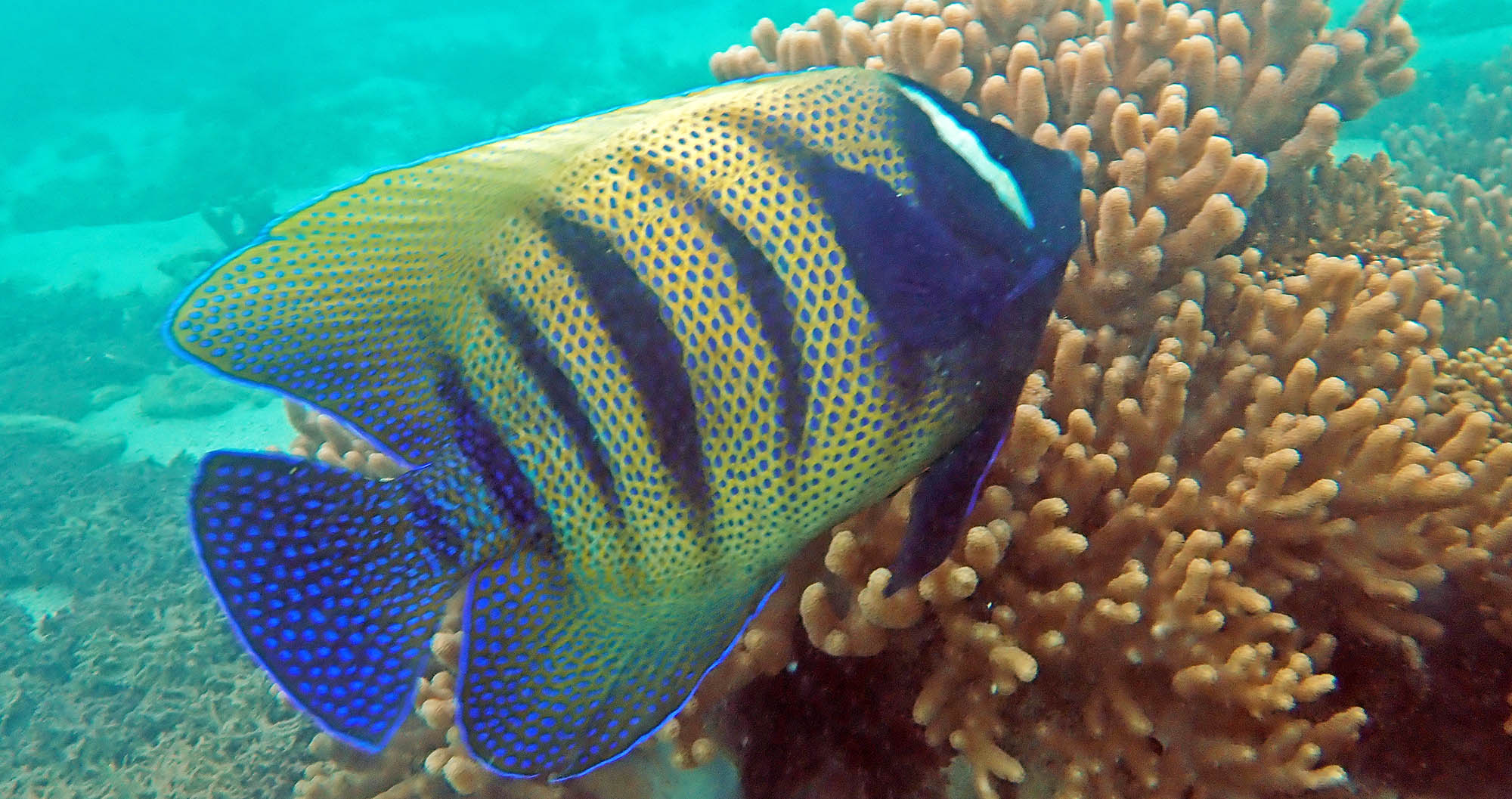 'Sixband/Sixbar Angelfish', (Fitzroy Island, Queensland).
'Sixband/Sixbar Angelfish', (Fitzroy Island, Queensland).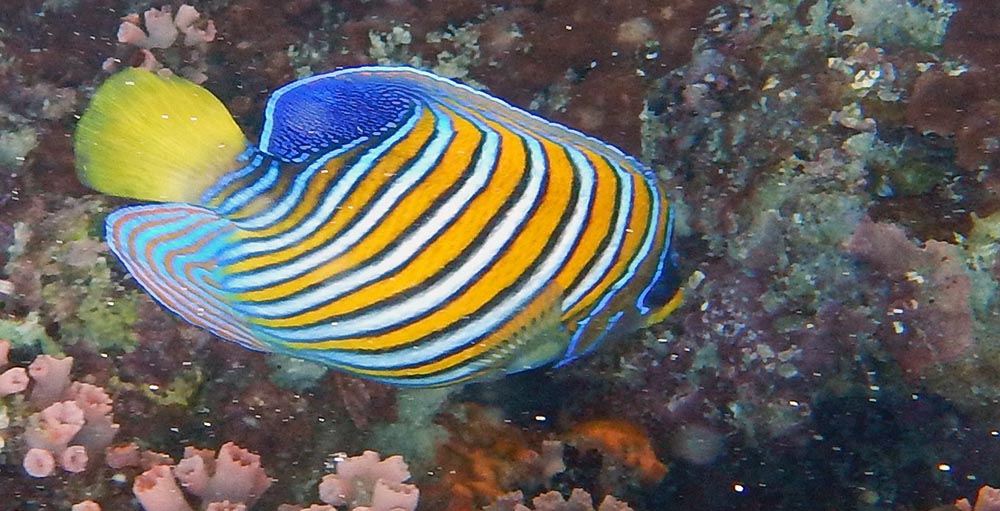 'Regal Angelfish', (Bali Barat NP, Indonesia).
'Regal Angelfish', (Bali Barat NP, Indonesia).The 'Surgeonfish' of the family Acanthuridae are medium sized fish usually distinguished by spines on the bridge between the body and the tail.
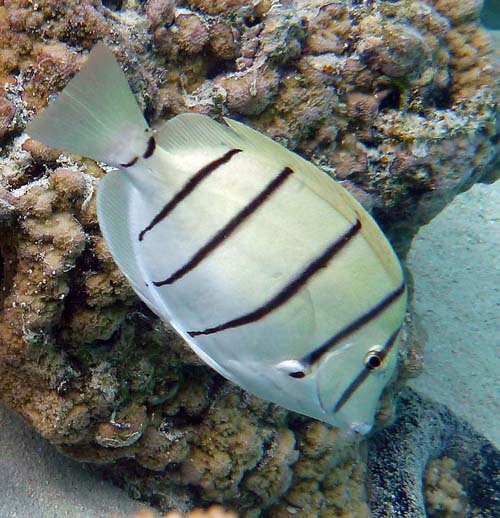 'Convict Tang', (Aitutaki Fiji).
'Convict Tang', (Aitutaki Fiji).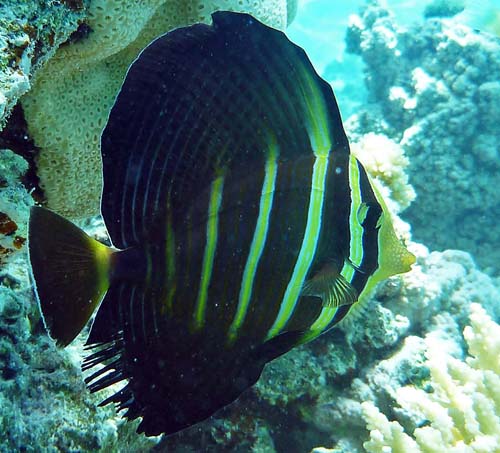 'Sailfin Tang', (Aitutaki Fiji).
'Sailfin Tang', (Aitutaki Fiji).The order Tetraodontiformes include several families of square or box like fish with fused teeth, such as filefish, trunkfish, boxfish, pufferfish, and triggerfish.
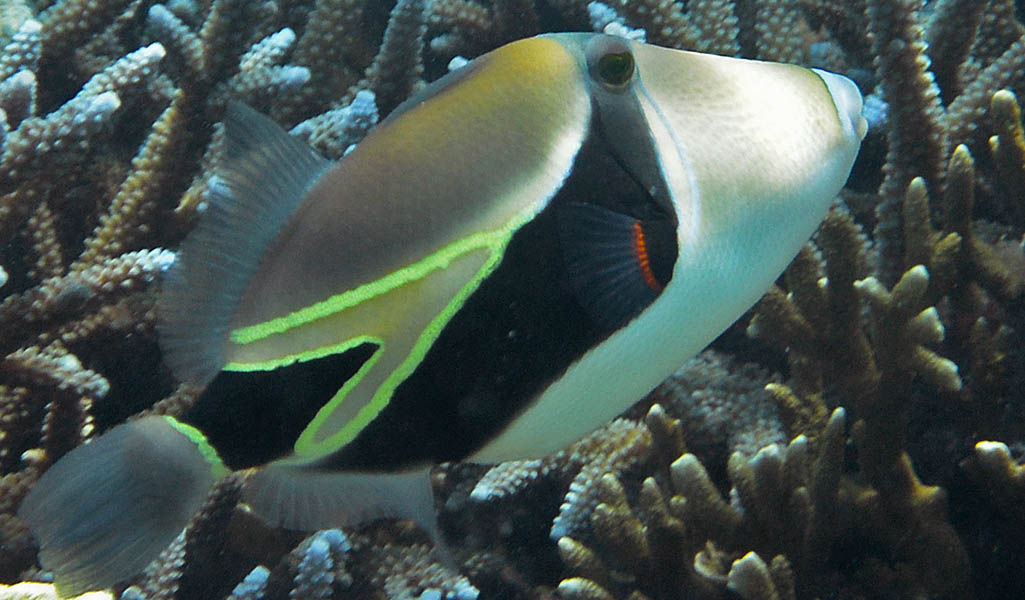 'Black-banded Triggerfish', (Miyako, Japan).
'Black-banded Triggerfish', (Miyako, Japan).There are half a dozen turtle species that can be seen around the tropical Indo-Pacific coral reefs. While they look superficially similar, they all have slight differences in their scale counts, but more importantly they all have different ecological niches, feeding on different things. The 'Green Turtle' is the most widespread and commonly seen of the marine turtles, and the adults feed on algae, sea grass and other vegetation underwater.
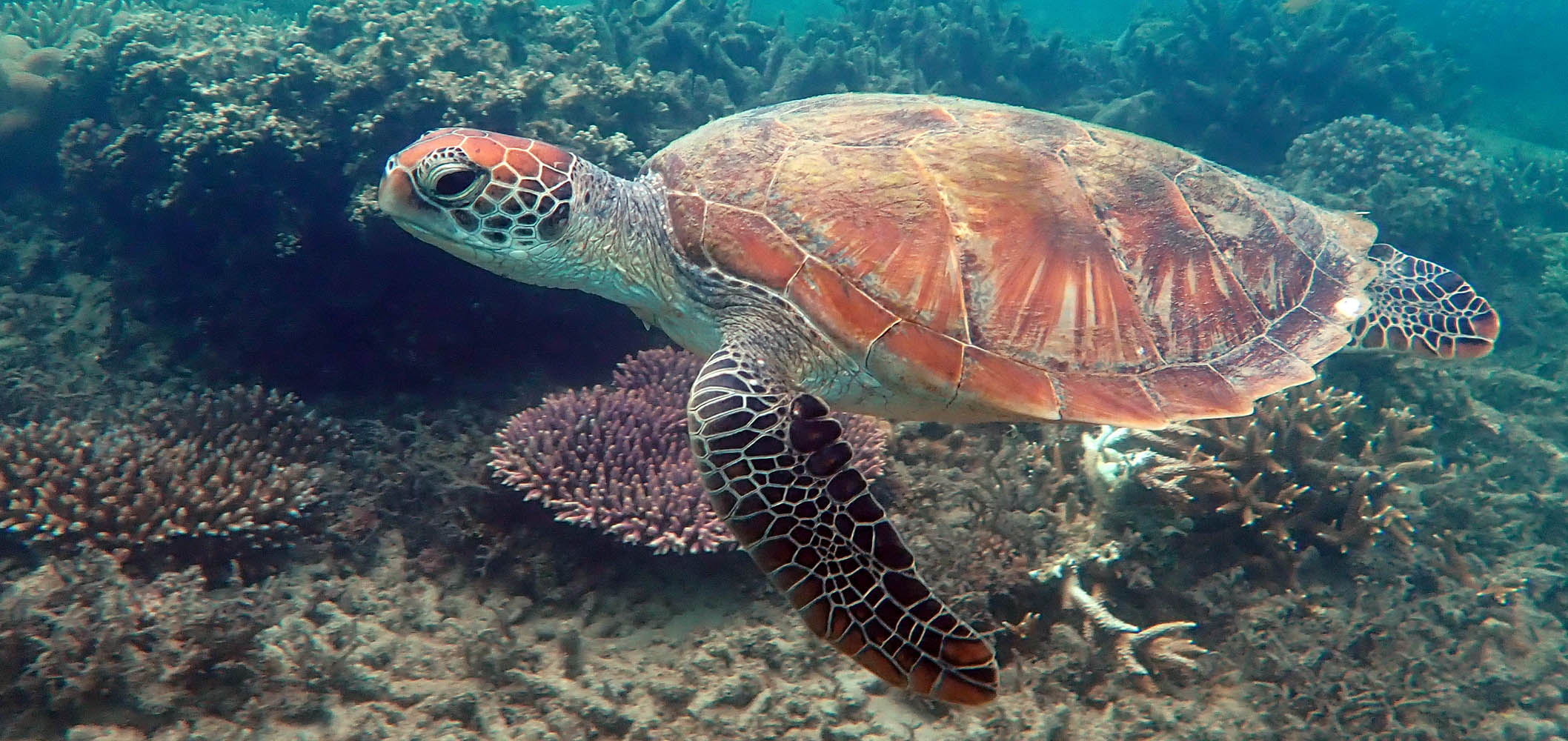 (Fitzroy Island, Queensland, Australia)
(Fitzroy Island, Queensland, Australia)While the 'true' sea snakes found be found around coral reefs, it is the smaller and slimmer 'Sea Kraits' of the subfamily Hydrophiinae that are seen more often around coral reefs. Both groups are related, but while the former are completely marine and can be found far out to sea, the Sea Kraits are amphibious, coming ashore to rest and breed, and they usually require adjacent uplifted limestone habitat to do this.
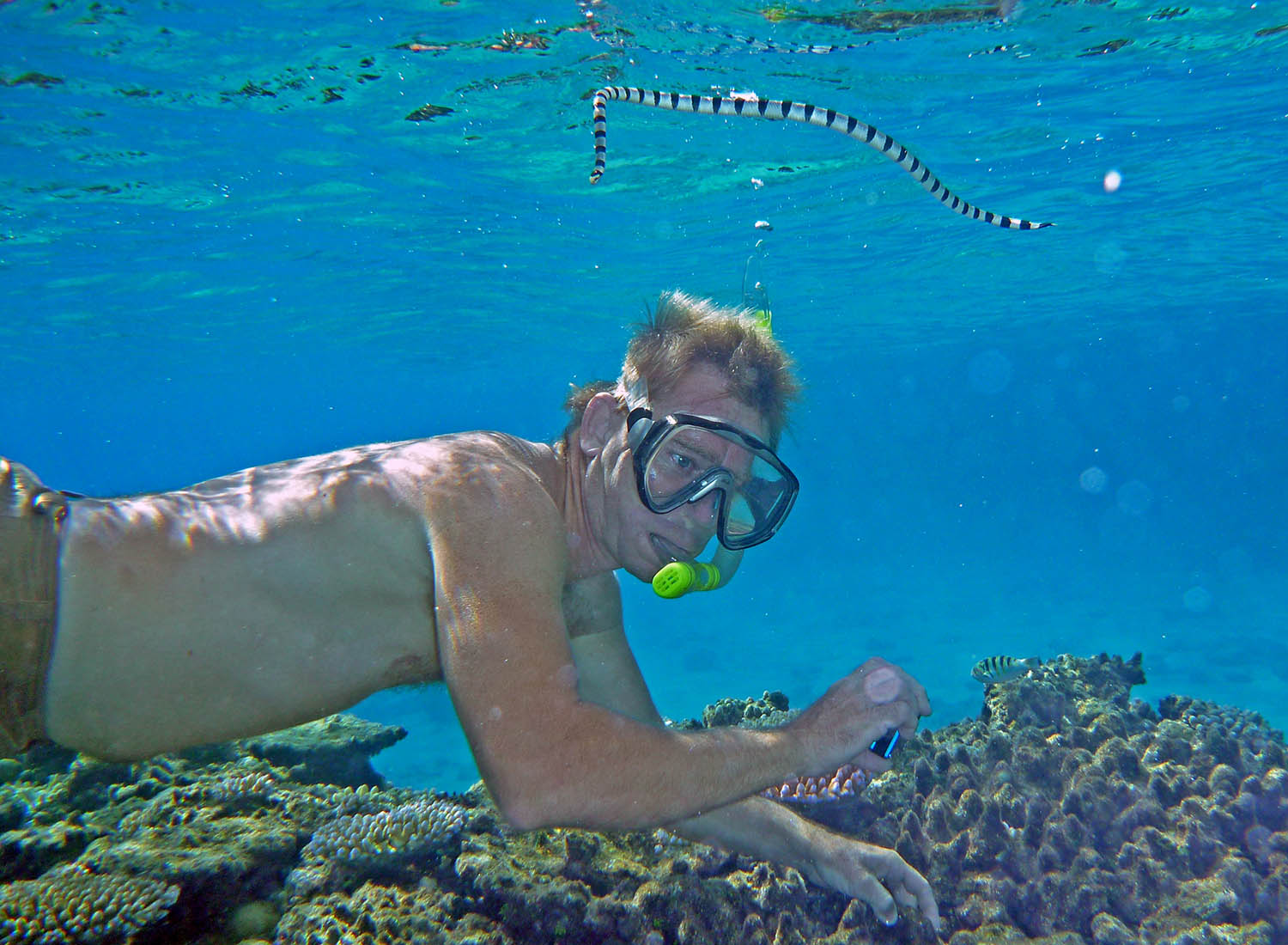 now, there was a sea krait around here somewhere...(the author with a Sea Krait)
now, there was a sea krait around here somewhere...(the author with a Sea Krait)The birds around coral reefs are mostly seen near shallow water at low tide. The most common species around the Indo-Pacific is the 'Eastern Reef Egret'.
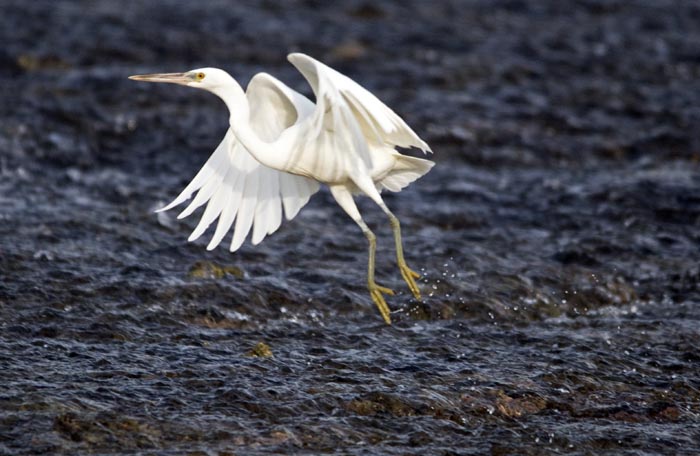
Places to see Indo-Pacific tropical coral reefs
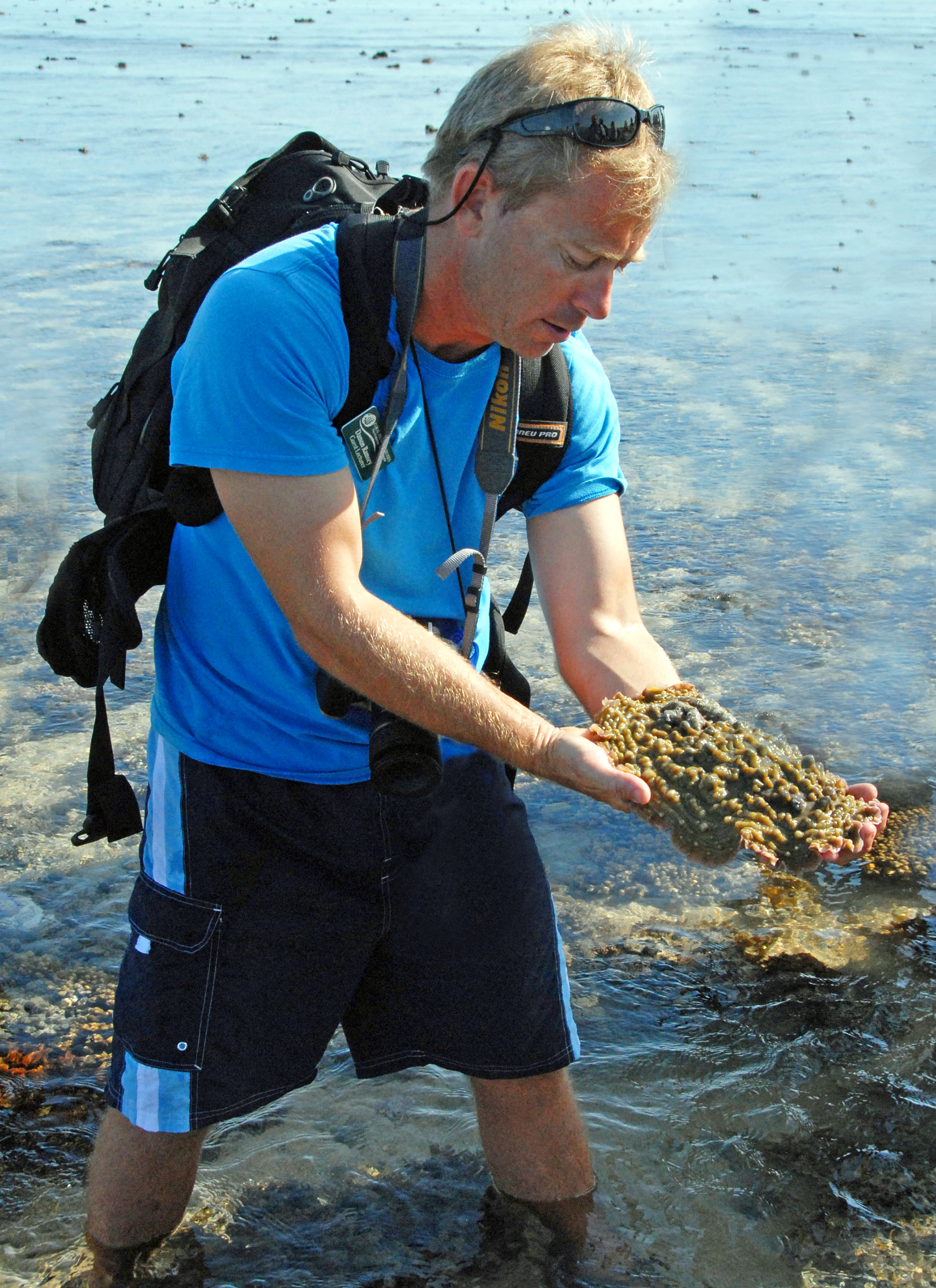 the author on a reef showing passengers coral (when he was a bit younger)
the author on a reef showing passengers coral (when he was a bit younger)The biggest reef in the world is of course the Great Barrier Reef, off eastern Australia. One of the best islands for reef is Lizard Island. Along the edge of this reef are the beautiful Ribbon Reefs. South of the Great Barrier Reef is some great coral and fish on the Tangalooma Wrecks. On the west coast of Australia there are other reefs, including Montgomery Reef in the north east (more for observing the tides than snorkelling), Ashmore Reef (hard to get to and more a base for our marine border) and further south is Ningaloo Reef (a bit cold, but the most accessible snorkelling from the Australian mainland). Even further south, and perhaps the most southerly coral reefs in the world are those around Houtman Abrolhos.
The south west Pacific includes the Solomon Islands, my favourite country for snorkelling. One of the best sites in this area is at Maravagi Resort, on Mangalonga Island. Other areas in the Solomon Islands include: Uepi Resort, Marovo Lagoon and Arnavon (Arnarvon) Islands.
At a similar latitude is the relatively unspoilt island of New Guinea. This is my second favourite coral reef region; both sides of New Guinea (Indonesian New Guinea and Papua New Guinea) have incredible snorkelling. This area includes the most diverse coral reefs in the world, at Rajah Ampat.
Dominating the Indo-Pacific coral reefs is the huge country of Indonesia, including Kakaban Island. Indonesia also includes: Menjangan Island, Bali Barat and Pink Beach Komodo.
Heading north there are the remote islands of Micronesia, including the stunning Palau. Then there is the diverse and many islands of the Philippines, including Panagsama. Even further north is the extent of tropical coral reefs, Japan. Here, snorkelling is easy at Miyako Island.
More remote areas across the vast Pacific include Aitutaki in the Cook Islands, Niue and further east Bora Bora, in French Polynesia.
On the other side of the Indian Ocean, off the coast of Africa, are the Seychelles. Included in this island group is Farquhar Atoll.



